What Is Digital Advertising?
Advertising is digital when you use online platforms to promote your products and services. Digital ads appear on search engines, social media, and websites.
Unlike traditional advertising on TV, radio, or print, digital ads have the advantage of precise targeting. They also let you personalize ad content to fit your intended recipients and the context of their online activities.
For instance, if someone in your target demographic searches for "buy dog food" on Google, they might see a search ad for your dog food delivery service. This ad is personalized based on your settings and the target audience’s search. The algorithm knows this is a product type the audience is already interested in.
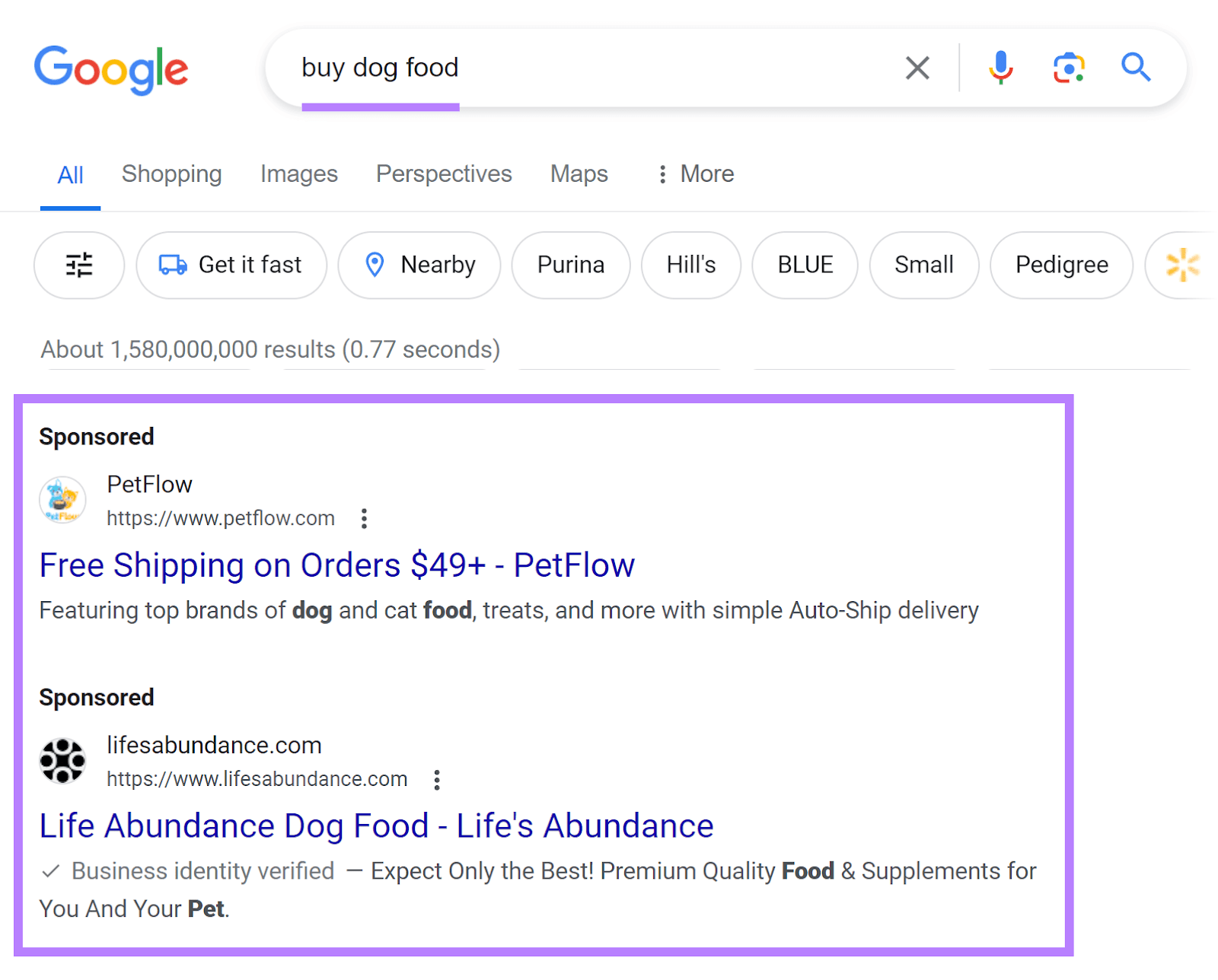
Digital advertising allows you to reach your audience on online platforms while they’re actively seeking information and entertainment. This makes your message more engaging since your ad is relevant to their current online activities and preferences.
Benefits of Digital Ads
Digital advertising has a lot of advantages:
- It reaches more people. Digital platforms offer access to a vast online audience (significantly larger than any single traditional medium can provide).
- It targets the right audience. Advanced targeting options let you use interests, behaviors, and engagement levels when setting audience criteria.
- It’s cost-effective. Digital ads are often budget-friendly. Accessible pricing combined with precise targeting options makes it possible to optimize your ad spend to focus on users who show the most interest.
- It’s measurable. You gain detailed insights with specific metrics like click-through rates, conversion rates, and engagement levels. This offers a clear picture of your campaign's performance and areas for improvement.
Digital Ad Pricing Models
The way you pay for digital ad campaigns varies depending on the platform and ad type.
The three most common pricing models are:
- Cost Per Click (CPC): You pay each time someone clicks on your ad
- Cost Per Mille (CPM): You pay for every thousand impressions your ad receives
- Cost Per Action (CPA): You pay when someone takes a specific action, like buying a product
What Are the Different Types of Digital Advertising?
Use different types of digital advertising campaigns to meet different marketing goals.
We can split digital ads into the following categories:
- Search engine advertising
- Social media advertising
- Content and native advertising
- Mobile advertising
- Visual and audio advertising
- Other types of advertising
Let’s look at the specific advertising formats within each category.
Search Engine Advertising
Search engine advertising helps show your ads to users searching for products or services like yours on search engines.
Here are five common types of search engine ads:
1. Search Ads
Directly connect with individuals searching for keywords related to your business through search ads.
These are text-based advertisements that appear on search engine results pages (SERPs). They're positioned alongside organic search results and are clearly labeled as ads.
Like this:
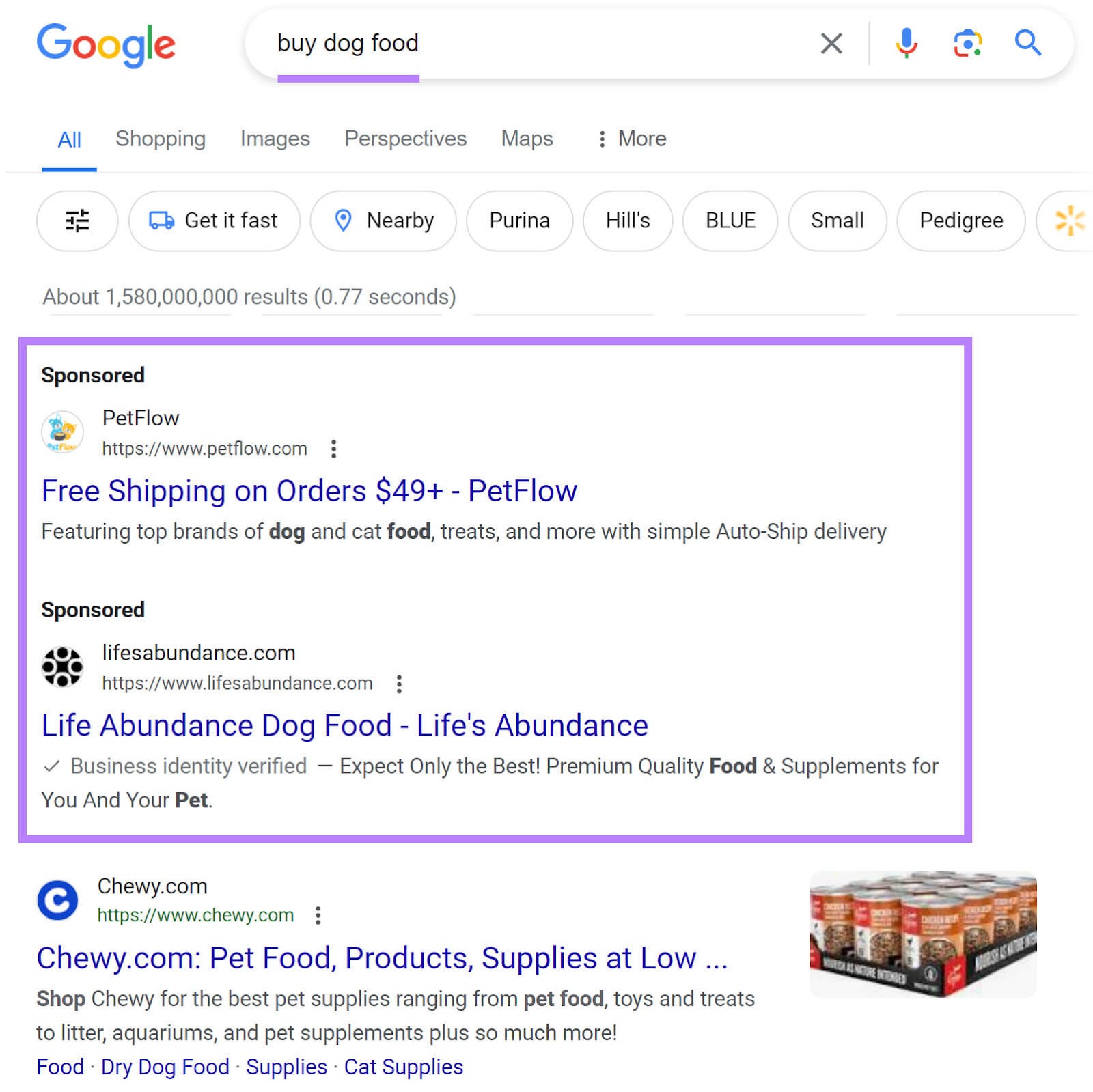
Search ads give you the flexibility to customize your ad's content, target specific keywords used in searches, and manage your budget to optimize your campaign performance.
Search ads can be a big help in attracting relevant traffic to your website. But you need to choose the right keywords.
How?
Look into your competitor’s search ad strategy to find:
- What keywords they are bidding on
- What keywords their ads appeared for recently
- How much are they paying per ad click
Find these insights and more with Advertising Research.
Open the tool, enter your competitor's domain, and click "Search."
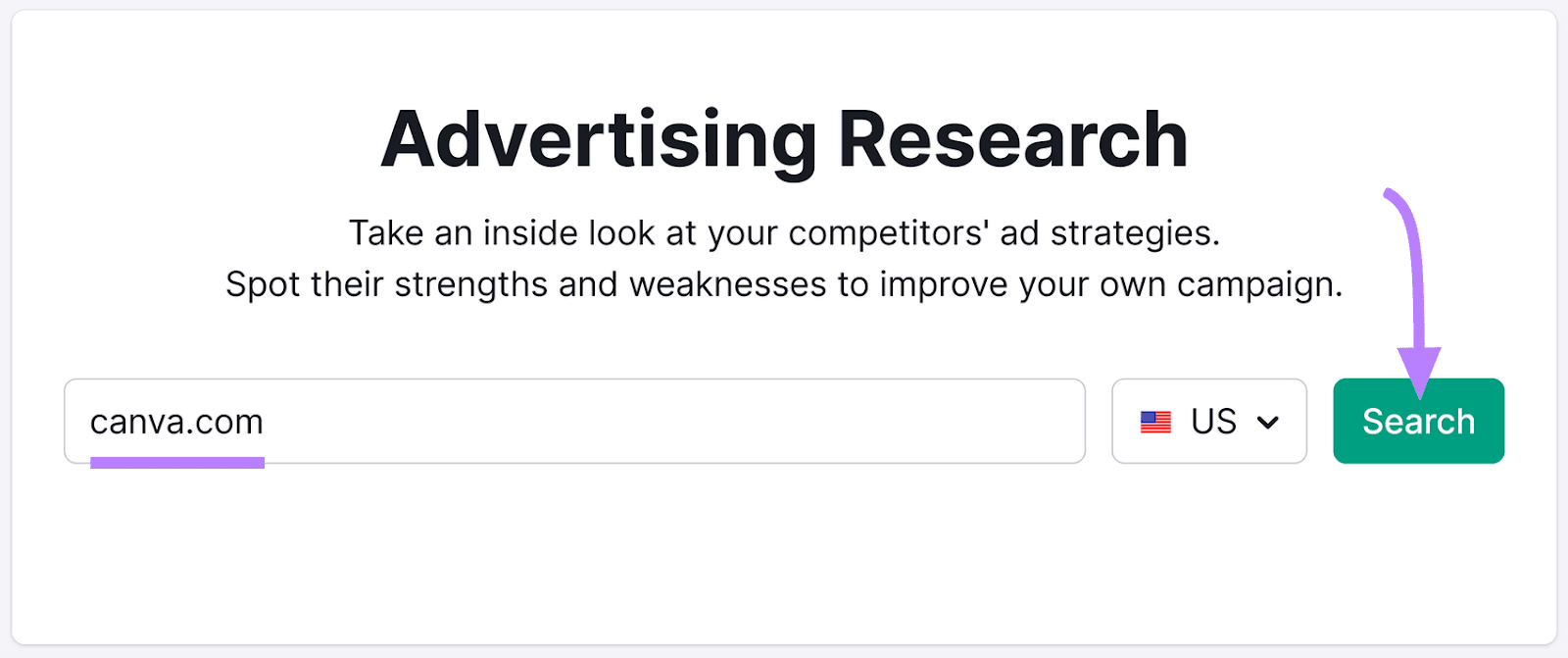
In the default "Positions" tab, scroll down to “Paid Search Positions.”
Here, in the “Keyword” column, you’ll see the terms your competitor’s ads rank for in Google's paid search results. Check out the “CPC” column to see how much they're paying for each click.
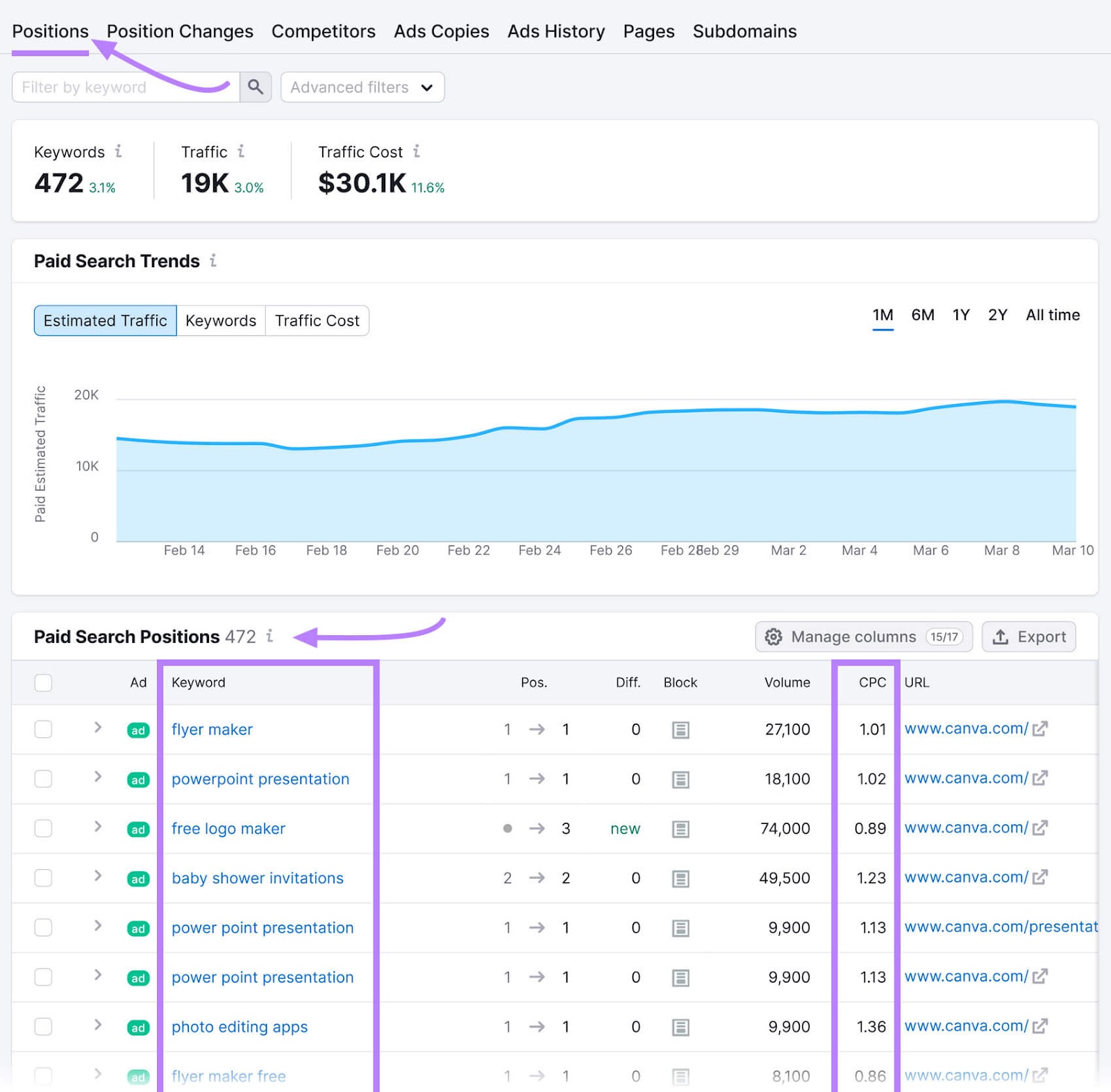
Next, click "Ads History."
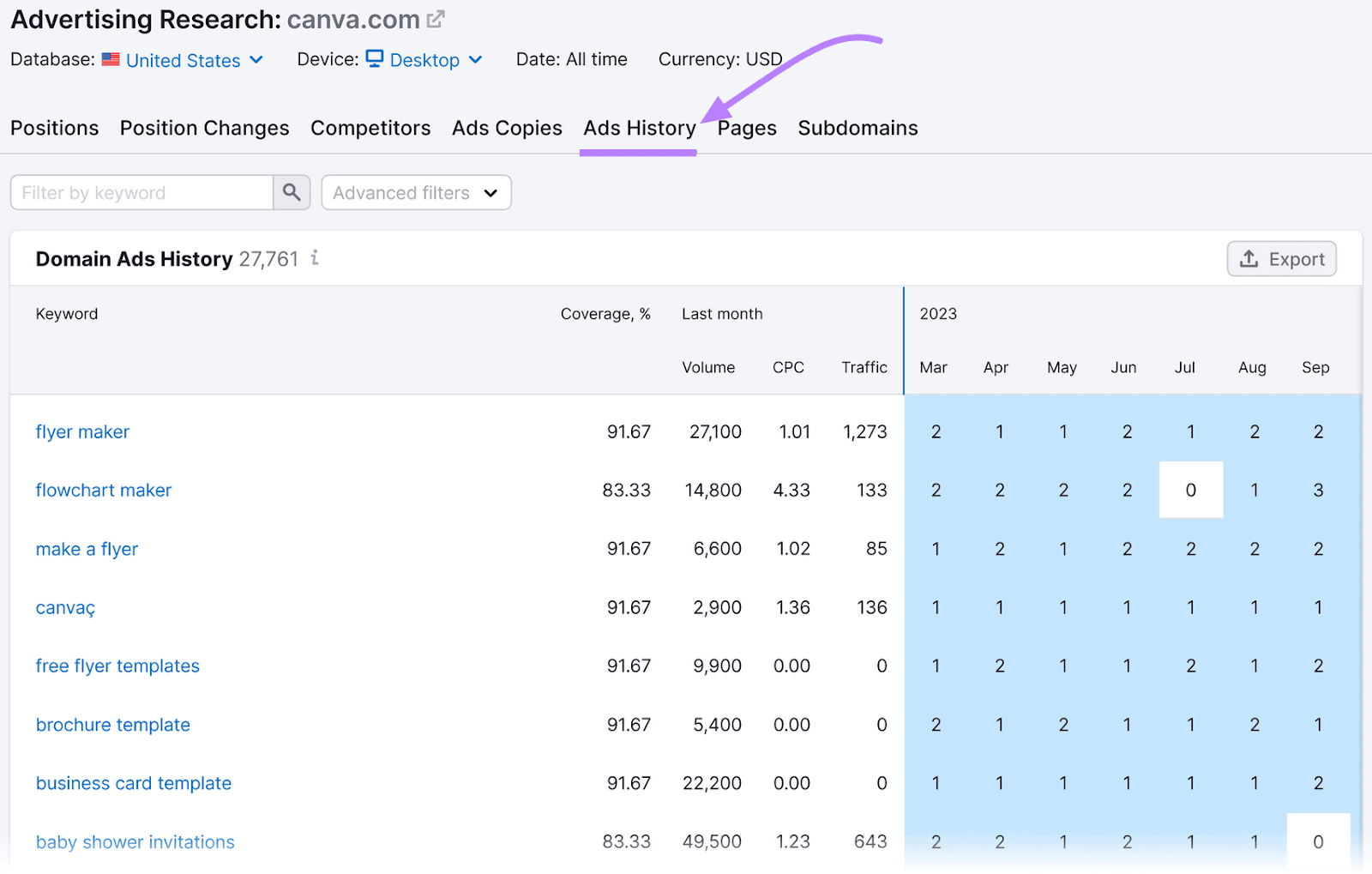
You'll see a snapshot of the keywords your competitor's ad has ranked for recently.
Based on these insights, build your keyword strategy. Plan to improve on what they’re offering. Or look for gaps—keywords they're missing.
For instance, if they haven't focused on "eco-friendly running shoes" and your product fits that description, targeting this keyword could attract customers they're not. With this keyword strategy, you're not competing head-on. You're capturing audiences in niches they're overlooking.
Setting a deliberate keyword strategy can make your ads more cost-effective. And potentially increase your return by reaching interested buyers more efficiently.
2. Display Ads
Use display ads to show up on websites that are part of a search engine's advertising network. Like Google Display Network.
Here’s an example of a display ad on Forbes’ homepage:
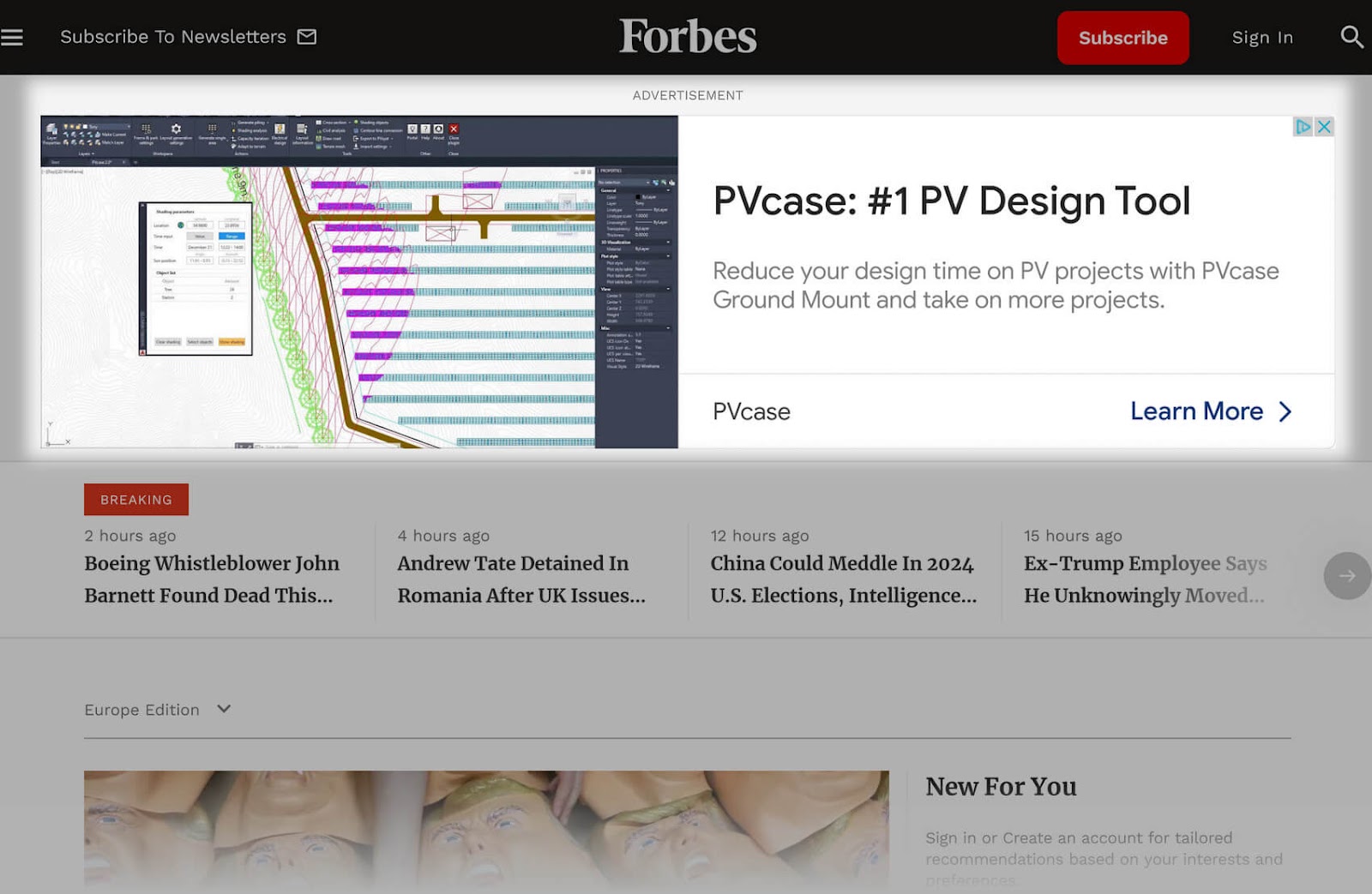
These ads (which may include images or videos) target users based on their interests and web browsing behavior.
For example, if you sell art supplies, you may set your display ads to appear on art-related websites. That way, you reach users who are likely to be interested in your products.
Display ads help increase brand visibility and attract potential customers to your website.
Like search ads, competitive analysis is key to creating effective display ad campaigns. When you learn what's working for competitors (and what's not), you can create better display ads that drive greater results.
The AdClarity tool from Semrush can help you look into your competitor's display ad campaigns, revealing:
- The ad platforms they're using
- Their display advertising spend
- Their campaign's performance stats
- Their ad’s messaging and visuals
Open the tool and enter your competitor's domain. Then click “Submit.”

You'll be taken to the main dashboard. It looks like this:
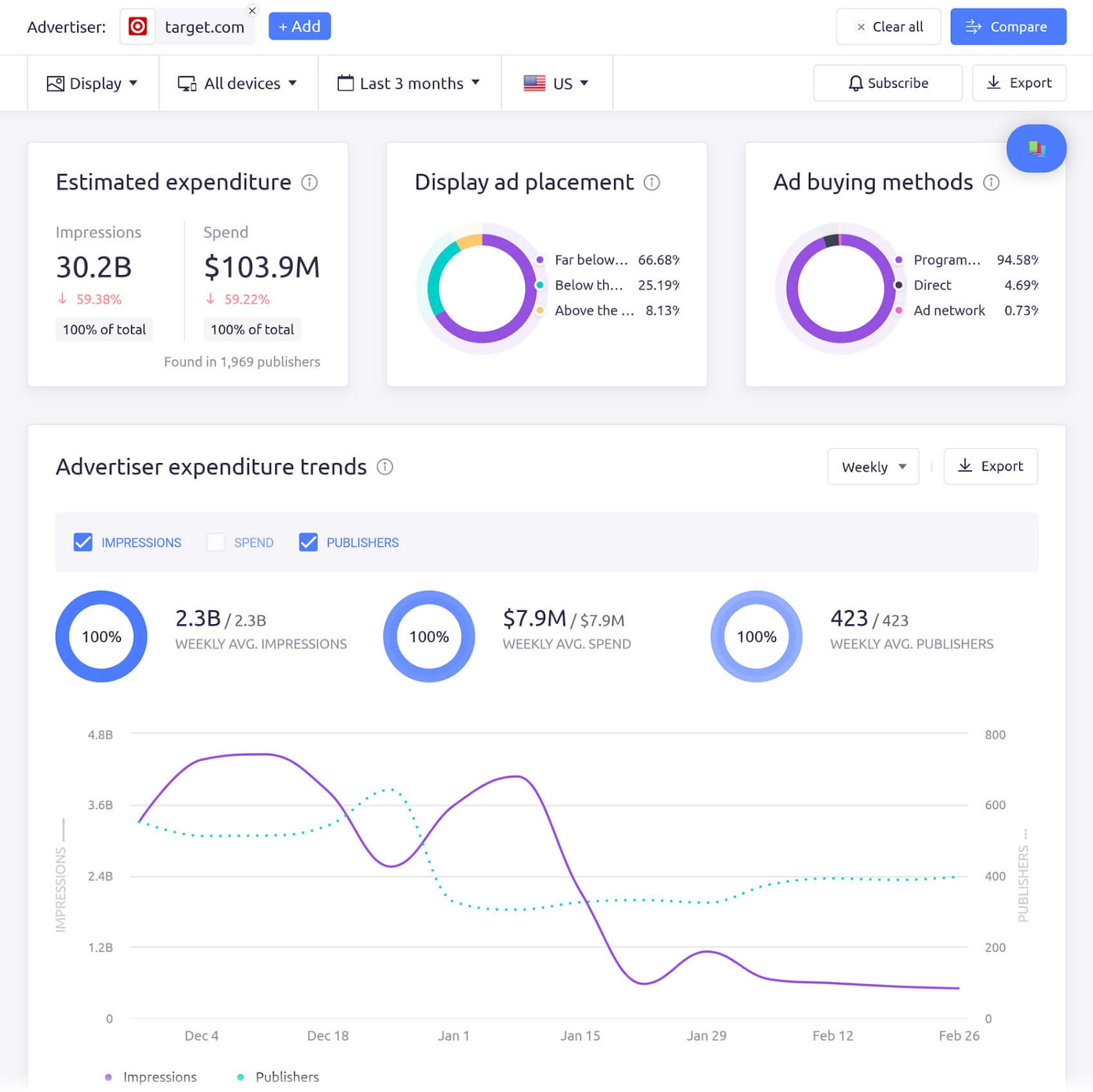
Scroll down to the "Top Ads" widget. Here, you'll see display ads from your competitors, other businesses in your industry, and those competing for similar ad space.
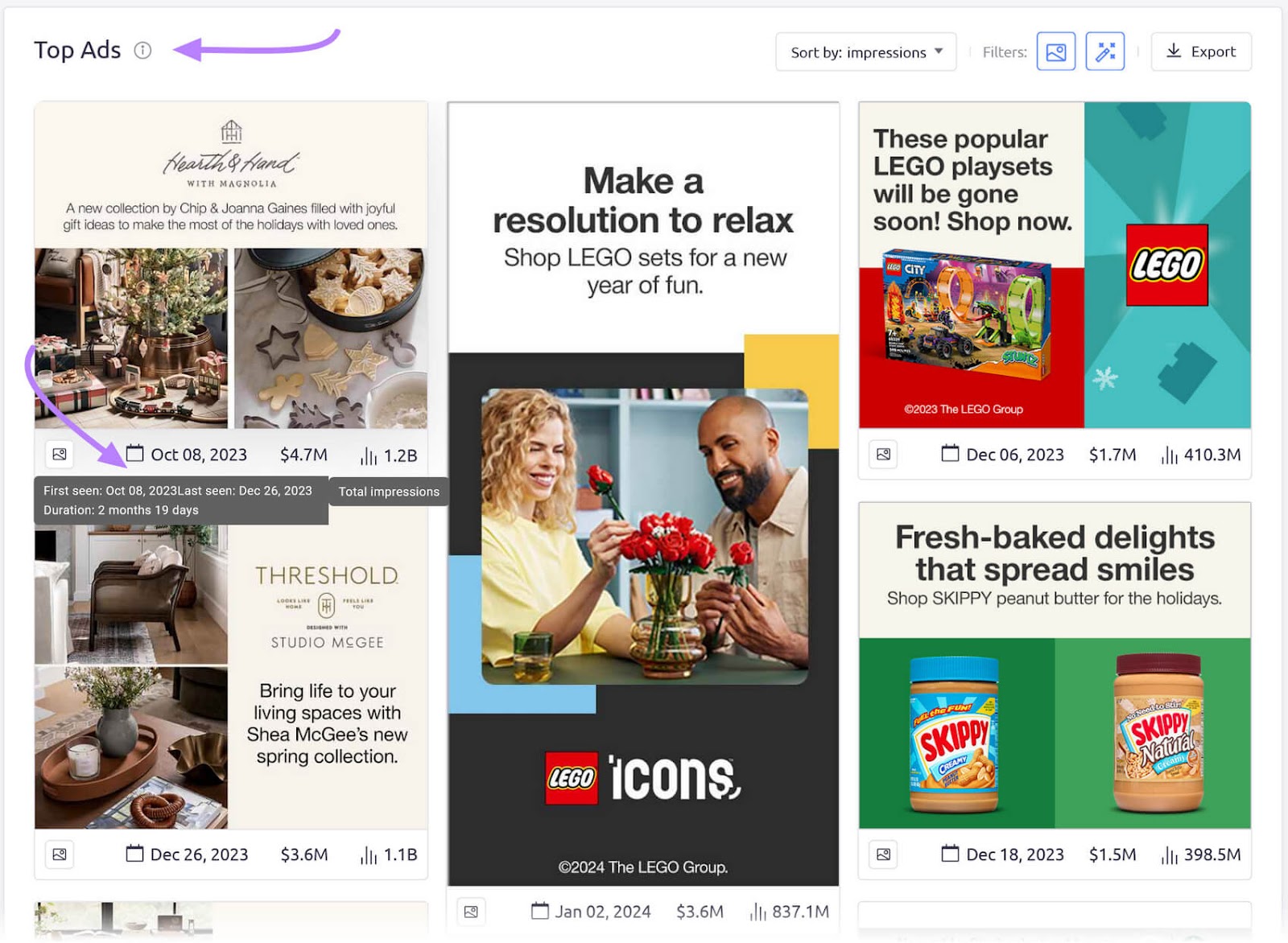
Notice: The “Top Ads” section provides data on the number of impressions the ad received, how long the ad has been running (duration), and how recently it was seen (recency).
Click on any ad to see a full campaign report.
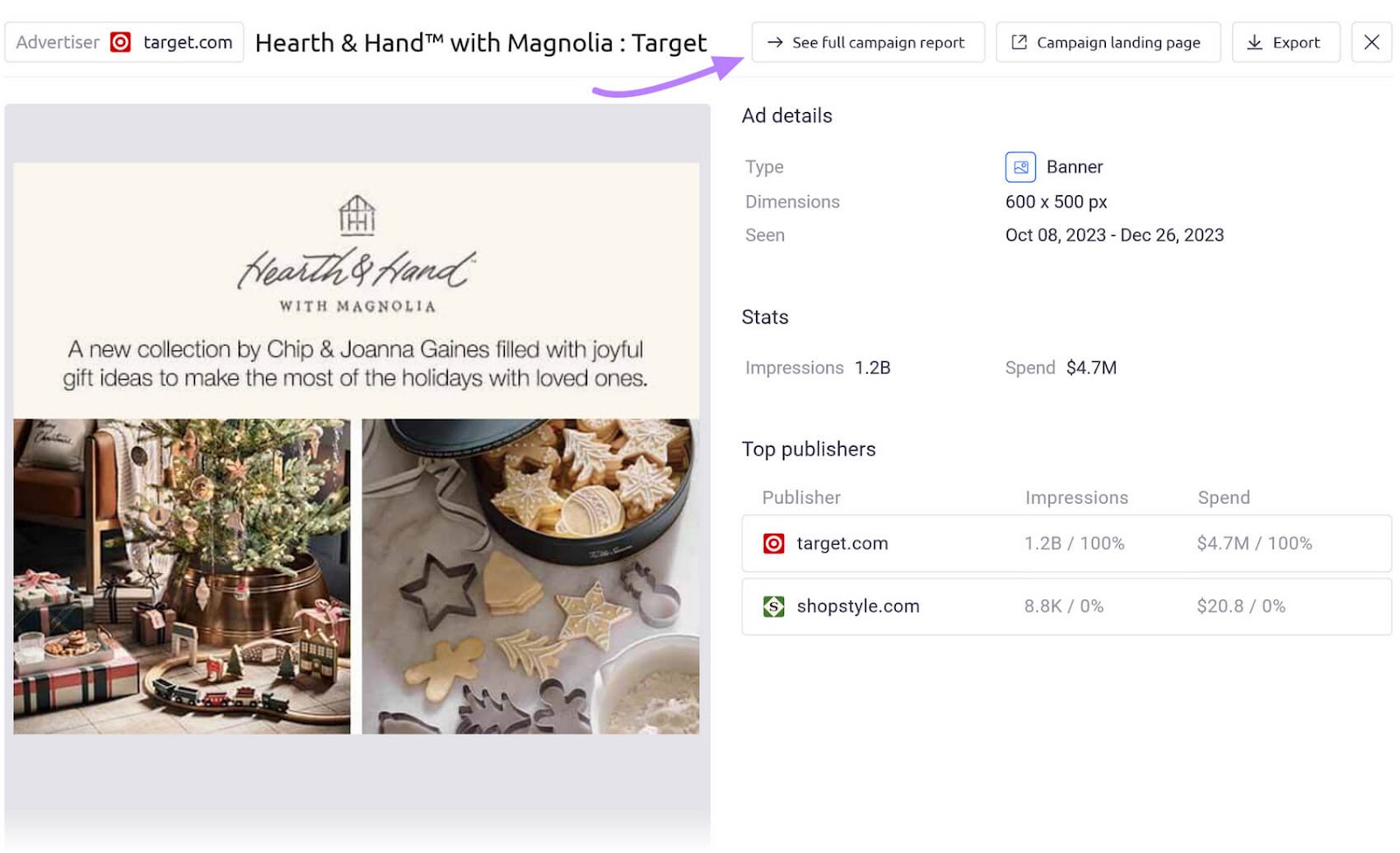
Use these insights to tailor your own display ad strategy.
Focus on ads with high impressions to understand placement strategies that are capturing attention. Analyze successful ads for creative inspiration. And ensure your visuals are compelling enough to stand out.
3. Shopping Ads
Also called Product Listing Ads (PLAs), shopping ads display your products directly in search results. These ads feature product images, prices, store names, and other decision-making details.
When users search for a product, such as "headphones," they see a presentation of what you offer alongside similar products from other sellers.
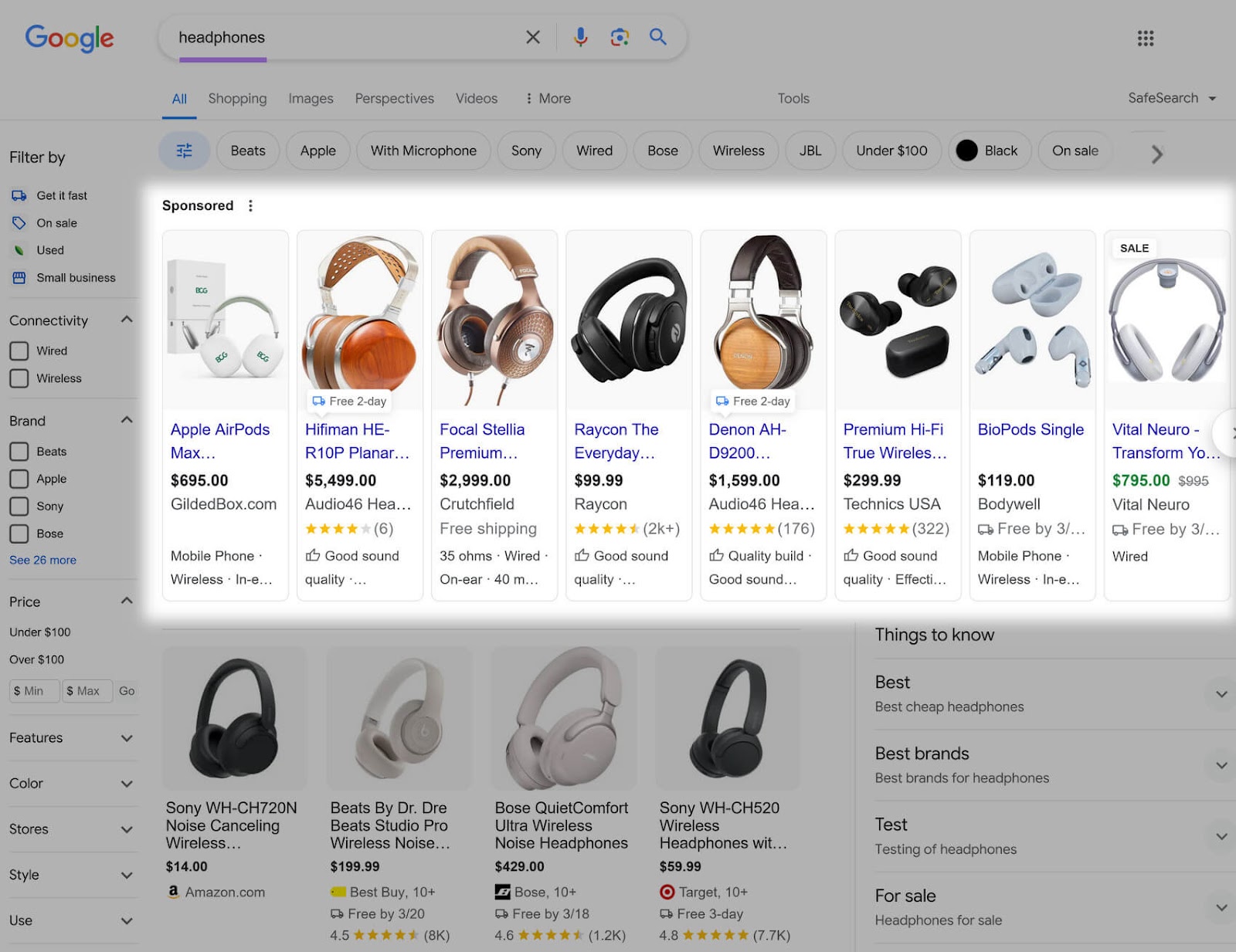
Shopping ads are great for ecommerce businesses because they enable shoppers to quickly compare products on the SERP and easily make purchase decisions.
Use the PLA Research tool from Semrush to analyze competitors’ PLAs, gain insights to create your own ecommerce strategy, and look at ad content plus keywords in detail.
Open the tool. Enter your competitor's domain, select a location from the drop-down if you want to, and click "Search."
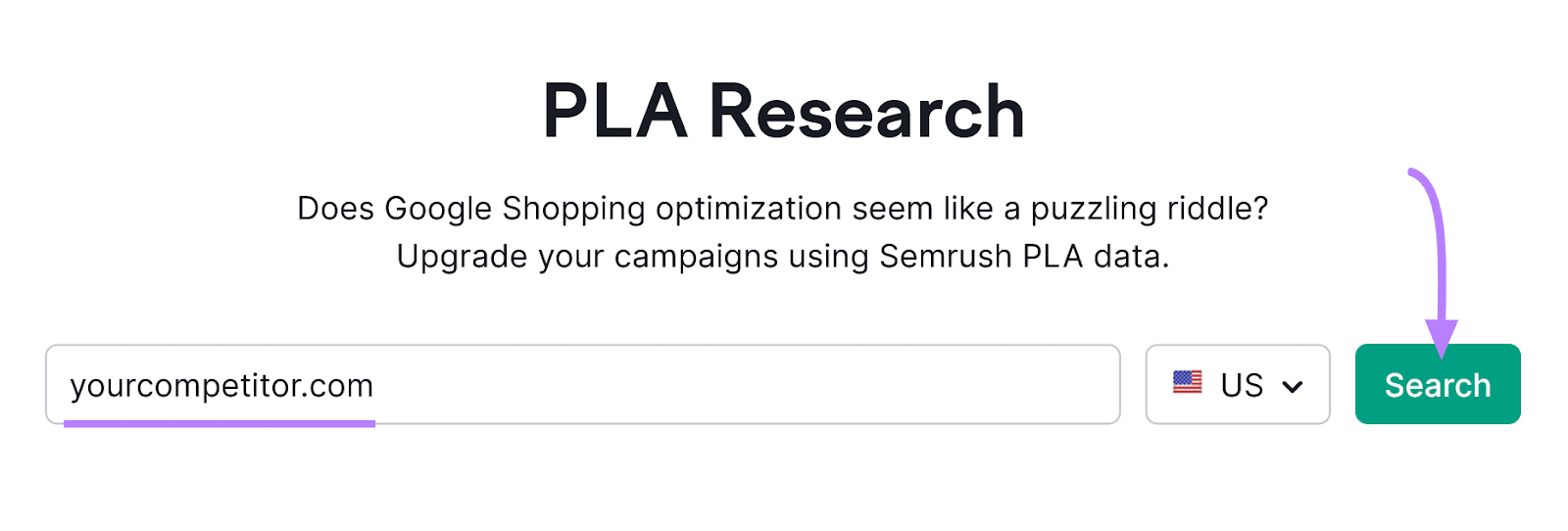
On the default "Positions" tab, scroll down to the “PLA Positions” section. Look for the “Keyword” column to see the list of keywords that trigger your competitor's product ads to appear on the SERP.
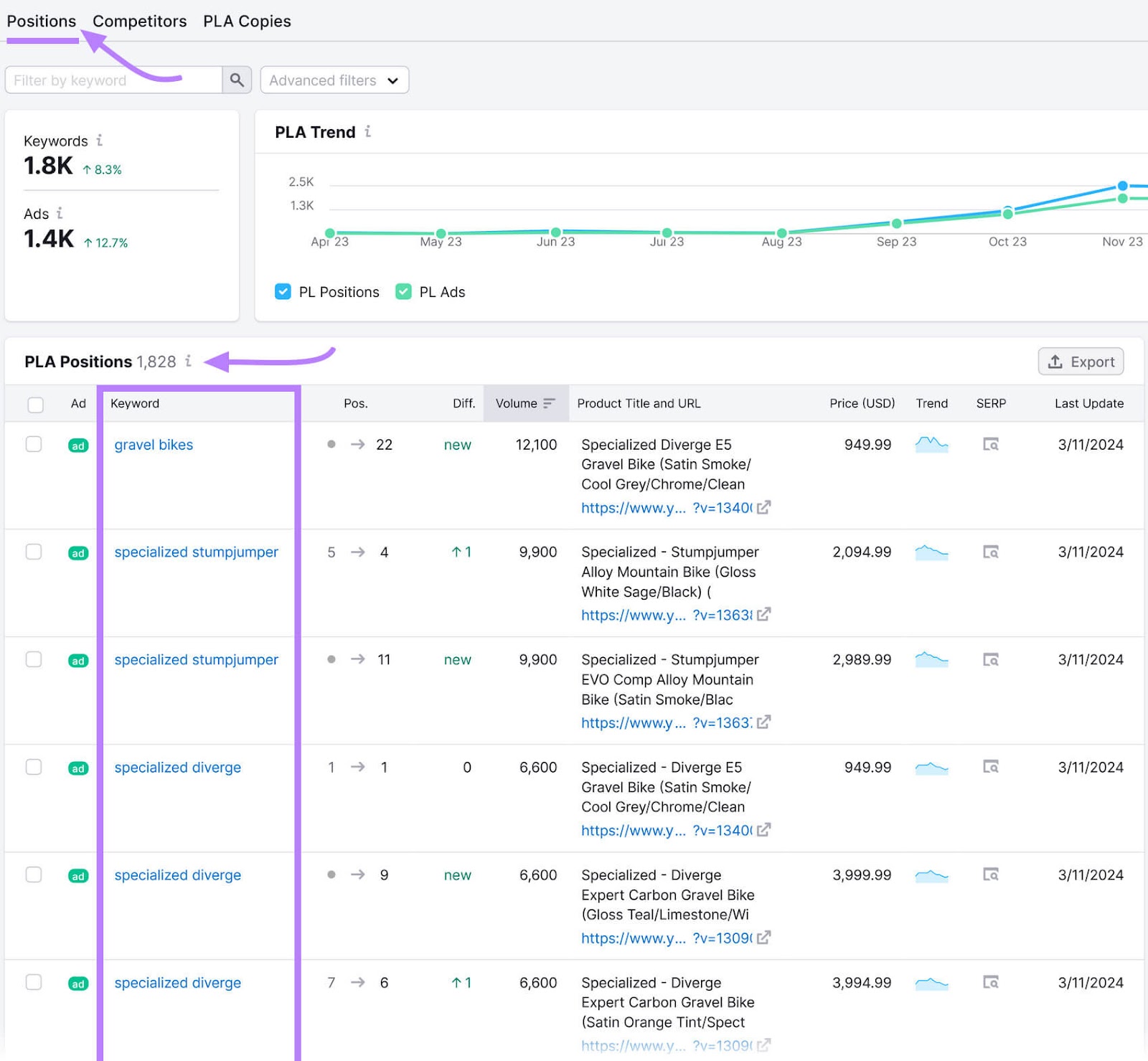
Head to the "Competitors" tab to find more domain names competing for the same keywords.
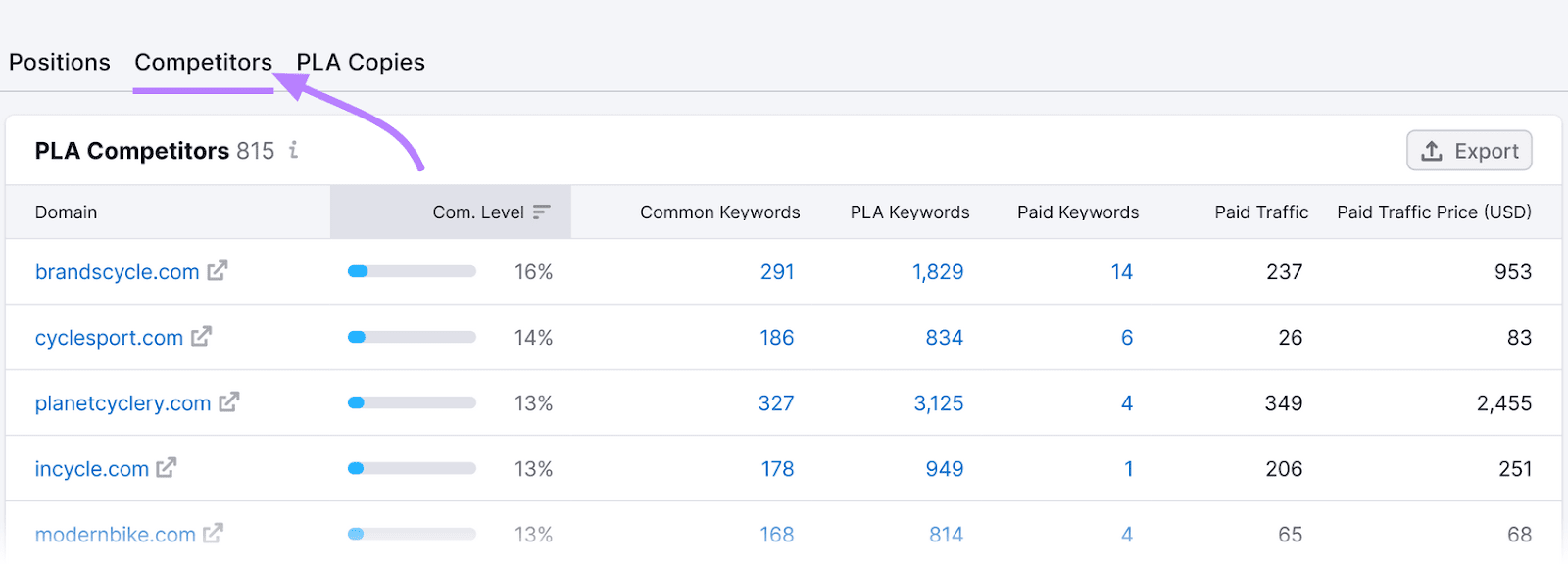
Use these insights to target the right keywords for your PLAs. Ideally, ones that have lower competition and higher paid traffic.
4. Local Search Ads
Target users who are searching for specific services or products near their physical location with local search ads.
Like: "Plumber near me."
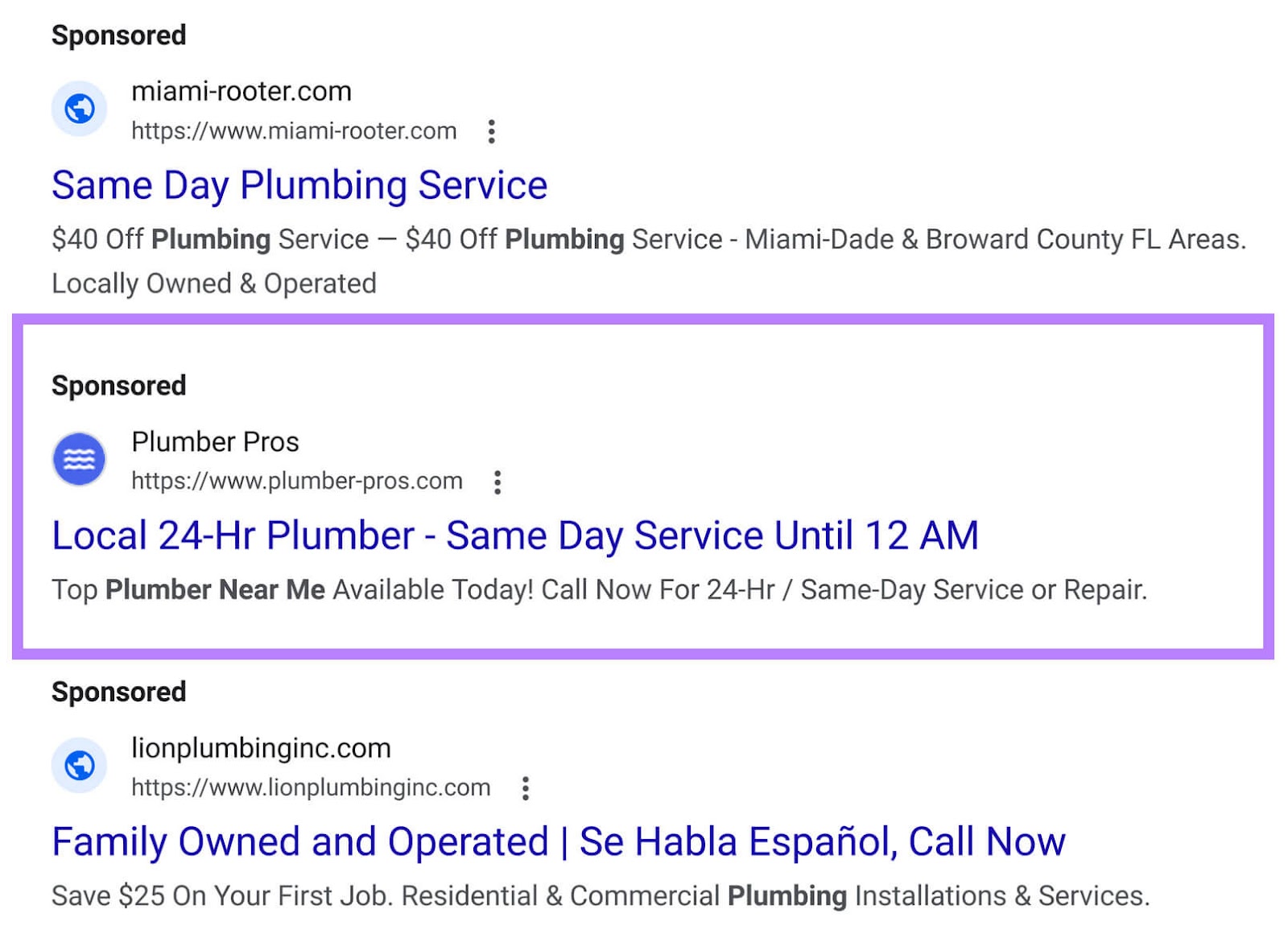
Local search ads act as a digital signpost. They guide potential customers directly to your business at the very moment they're ready to make a purchase from a business like yours.
These ads even display critical information like your company’s location, contact details, and hours of operation.
5. Dynamic Search Ads
Dynamic search ads (DSAs) appear in Google search results, blending in seamlessly with other ads. But they are distinguished by being dynamically generated. Their content is automatically created based on your website.
Here’s an example:
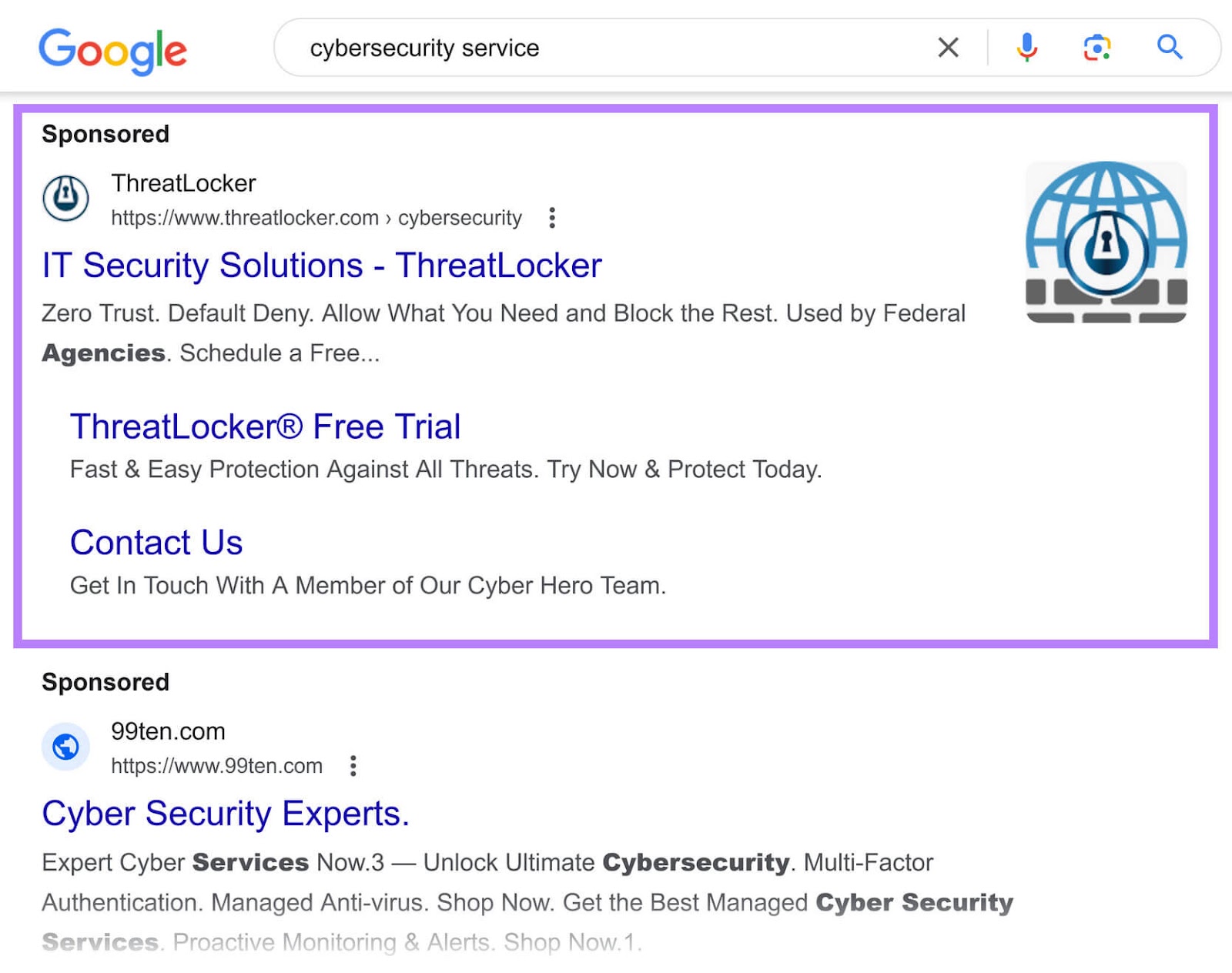
DSAs use Google's web crawling technology to extend your reach without manual keyword selection. They help you find potential customers your regular ads might not reach by automatically covering more search terms.
They also save you the trouble of writing ad copy. DSAs use the content from your website directly. For them to be effective, your website's content must be clear and well-organized.
Dynamic search ads are best for businesses that have a lot of products or update their website often. This way, ads can be shown for every product offered without having to manually set up each ad.
Social Media Advertising
Target audiences on platforms like Facebook, Instagram, and X (formerly Twitter) with social media advertising.
Each platform offers unique ad formats for different marketing goals.
For example, X allows businesses to sponsor trending topics. This can drive brand awareness or bring people's attention to ongoing campaigns.
Here are six types of digital advertising formats available on social media:
6. Sponsored Posts
Reach your audience seamlessly on social media with sponsored posts that blend in.
For instance, if you're promoting a new coffee blend, a sponsored post targeting users interested in coffee can fit right into their usual social feed.
Sponsored posts look just like ordinary social posts, but they’re marked with a "Sponsored" or “Promoted” label to indicate they’re an ad.
They look like this on X:
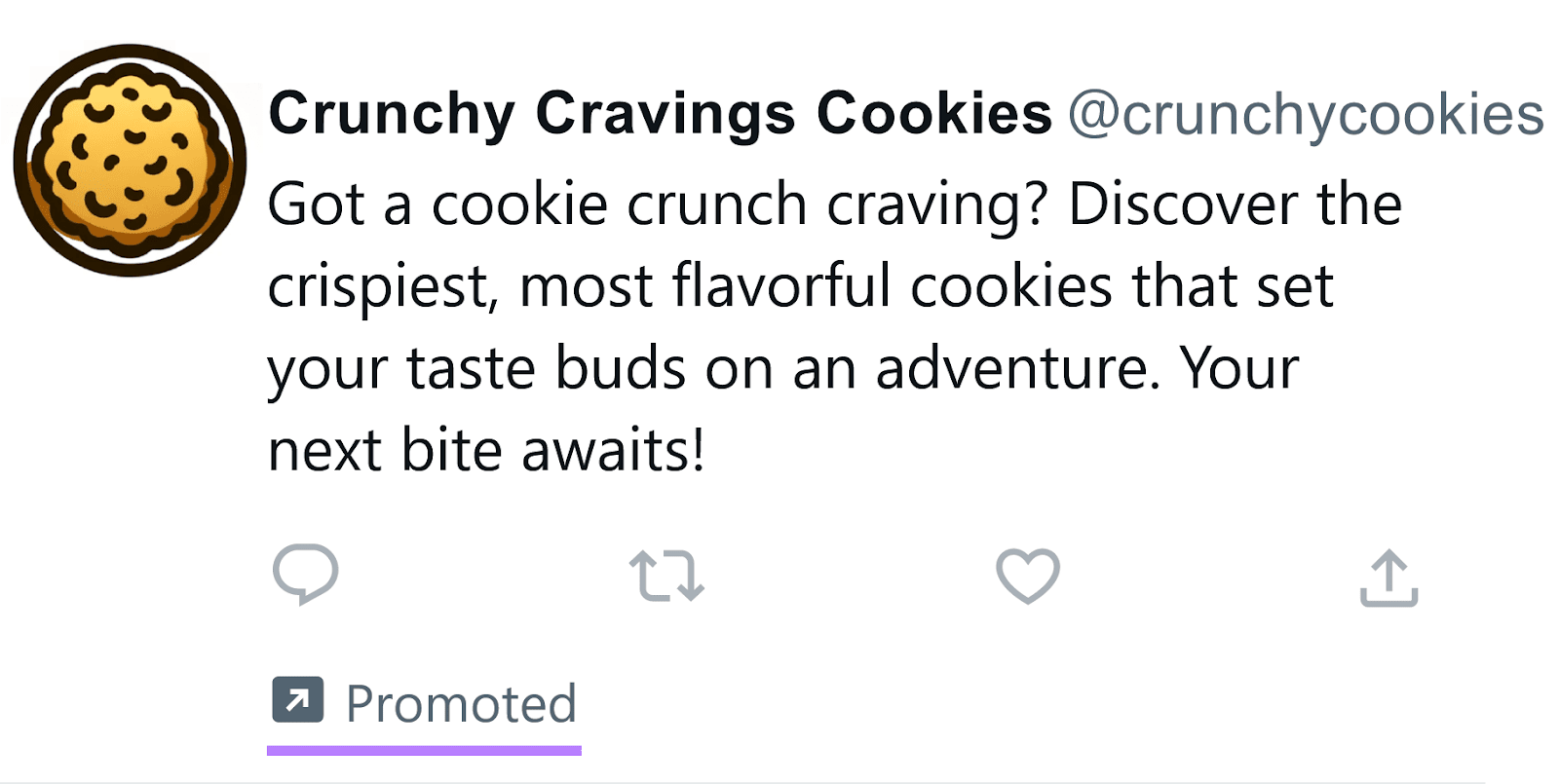
You pay for these posts to reach a specific audience directly in their news feeds. Choose the audience based on targeting options that include demographics, interests, and behaviors.
These flexible targeting options help ensure that potential customers most interested in your offering see your ad. Precision audience selection increases the chances of engagement.
7. Static Image Ads
Capture users' attention and encourage them to act with static image ads. They consist of a single image coupled with text.
These ads aim to intrigue and inform users as they scroll through their feeds.
Here’s how they look on Instagram:
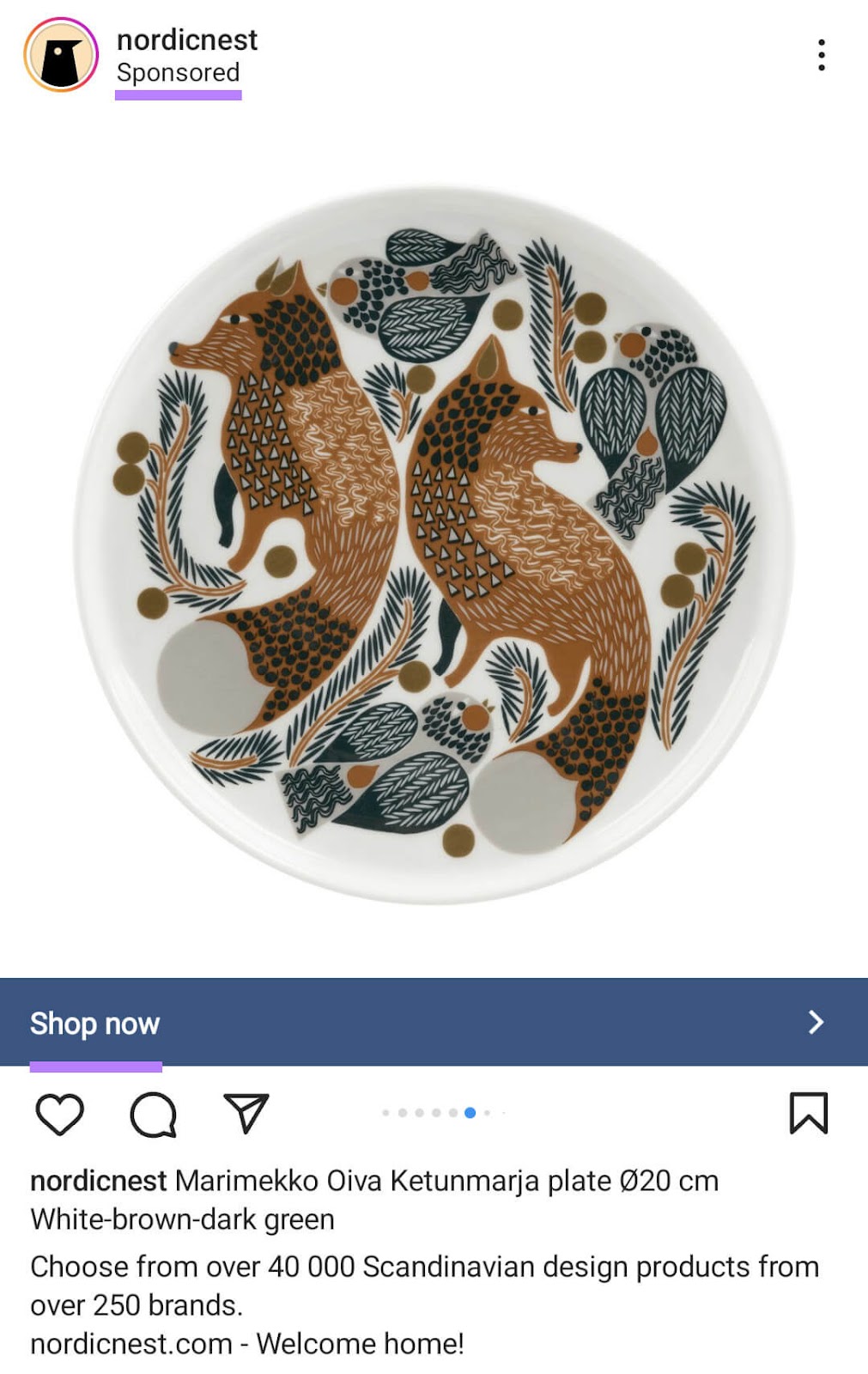
When creating a static image ad, you'll choose an image that stands out, write concise, persuasive copy, and include a clear call to action (CTA) like "Shop Now" or "Learn More."
For instance, if you're advertising handmade jewelry on Pinterest, you want to select a high-quality image that highlights the craftsmanship and beauty of your pieces, then pair it with a message that speaks directly to the viewer's desire for unique accessories.
8. Carousel Ads
Showcase multiple images or videos in a single ad unit with carousel ads. Each piece of content in the carousel can link to different pages on your website.
Users interact with these ads by swiping through the content, giving them control over the experience.
Here’s one on Facebook:
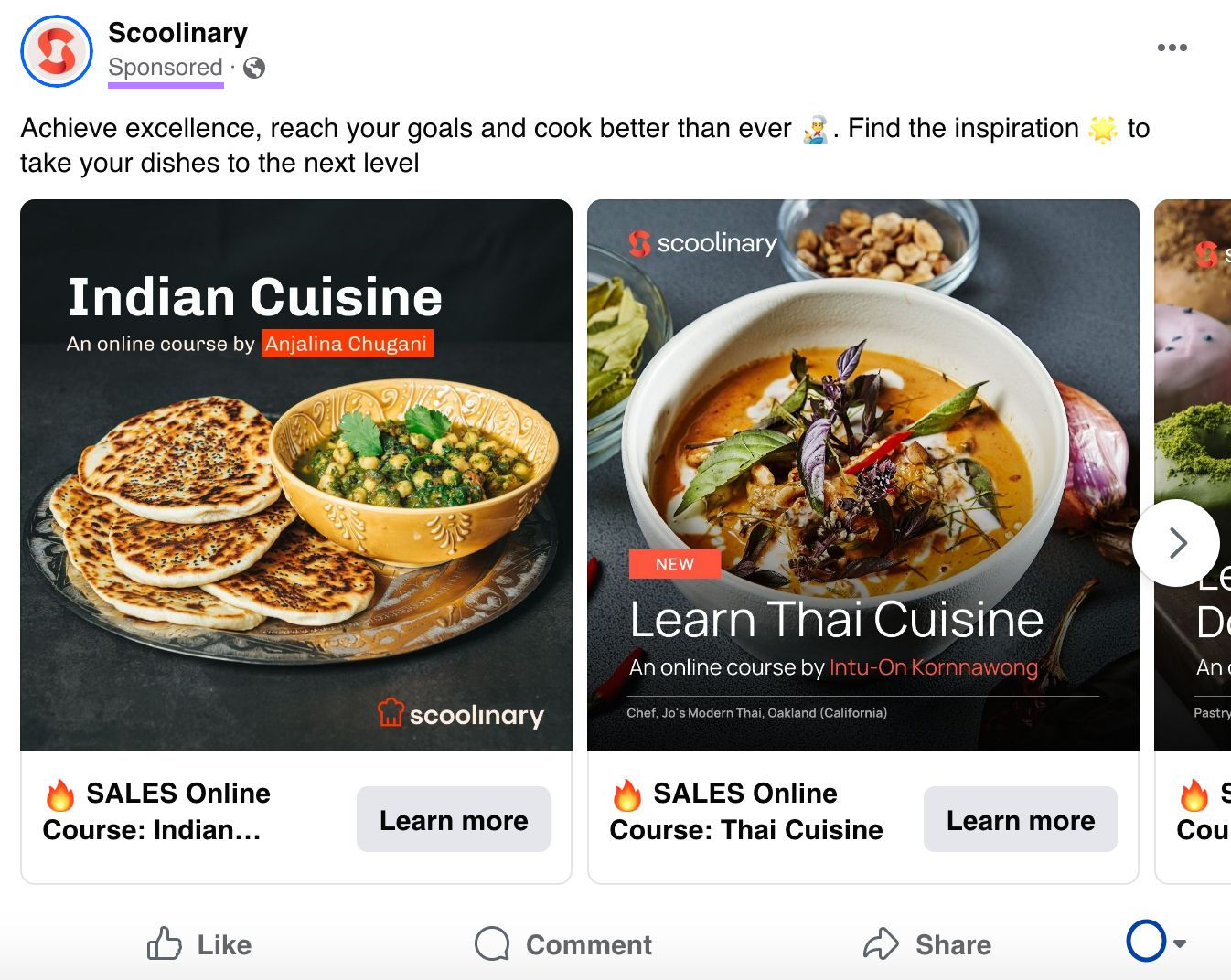
This format is perfect for when you want to highlight several specific products or tell a sequential story.
For example, if your business sells skincare products, you could use carousel ads on Facebook to feature different items, like cleansers, moisturizers, and serums. Each slide could explain the benefits and ingredients, guiding potential customers to see the full range and select products that meet their skin's needs.
9. Video Ads
Combine visual and auditory elements to showcase your products with video ads.
These can often be more effective in capturing attention than static image ads. The videos start playing automatically as users scroll through their feeds, offering a dynamic way to tell your brand's story.
Here’s how they look on LinkedIn:
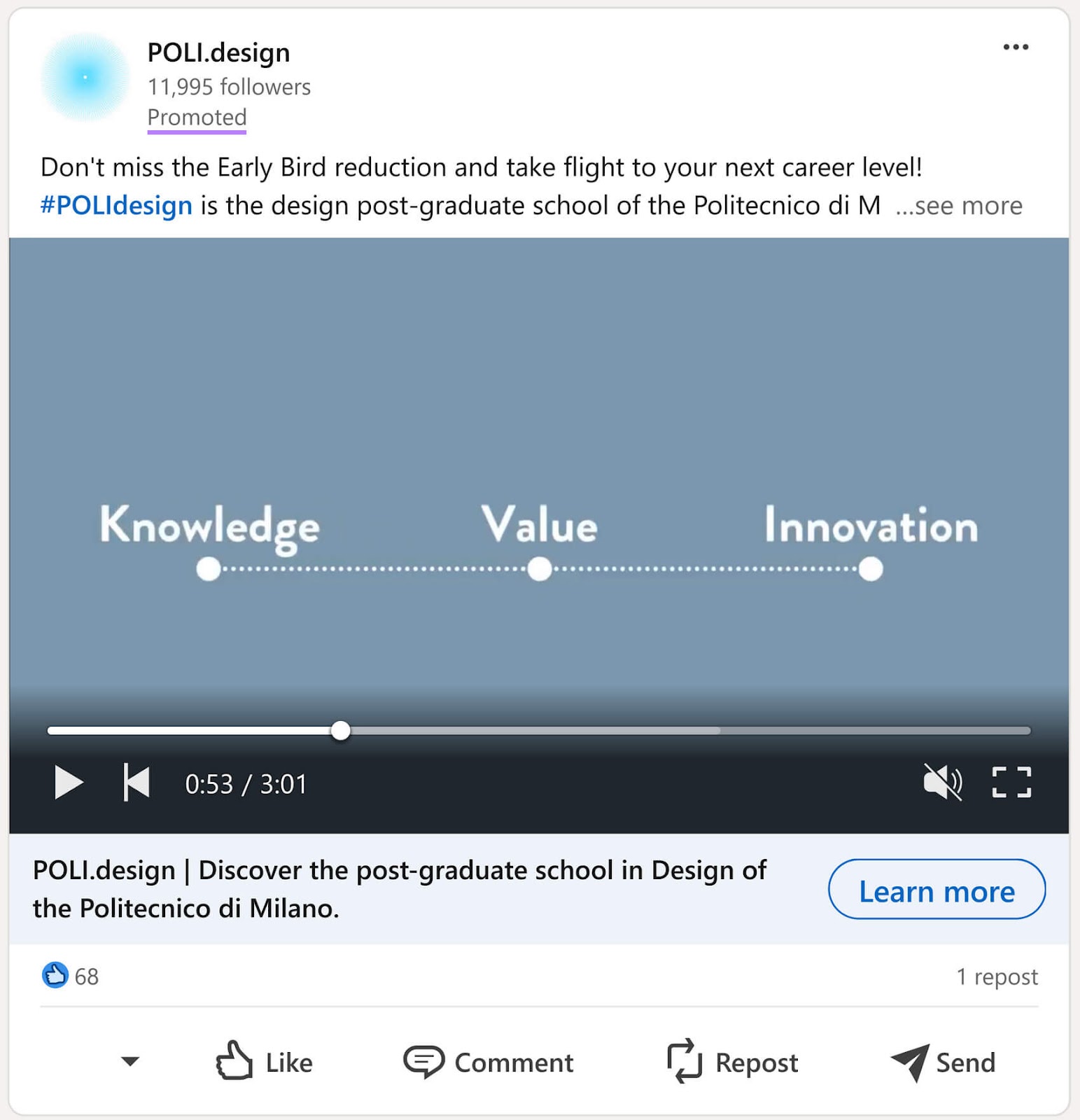
Video ads allow for creative storytelling.
For example, if you sell clothes, you can create a short, engaging video showcasing your latest collection, highlighting the unique styles and demonstrating how they fit into everyday life.
10. Stories Ads
Appear between users' stories on platforms like Instagram and Snapchat with stories ads. These ads last only 24 hours.
They look like this:
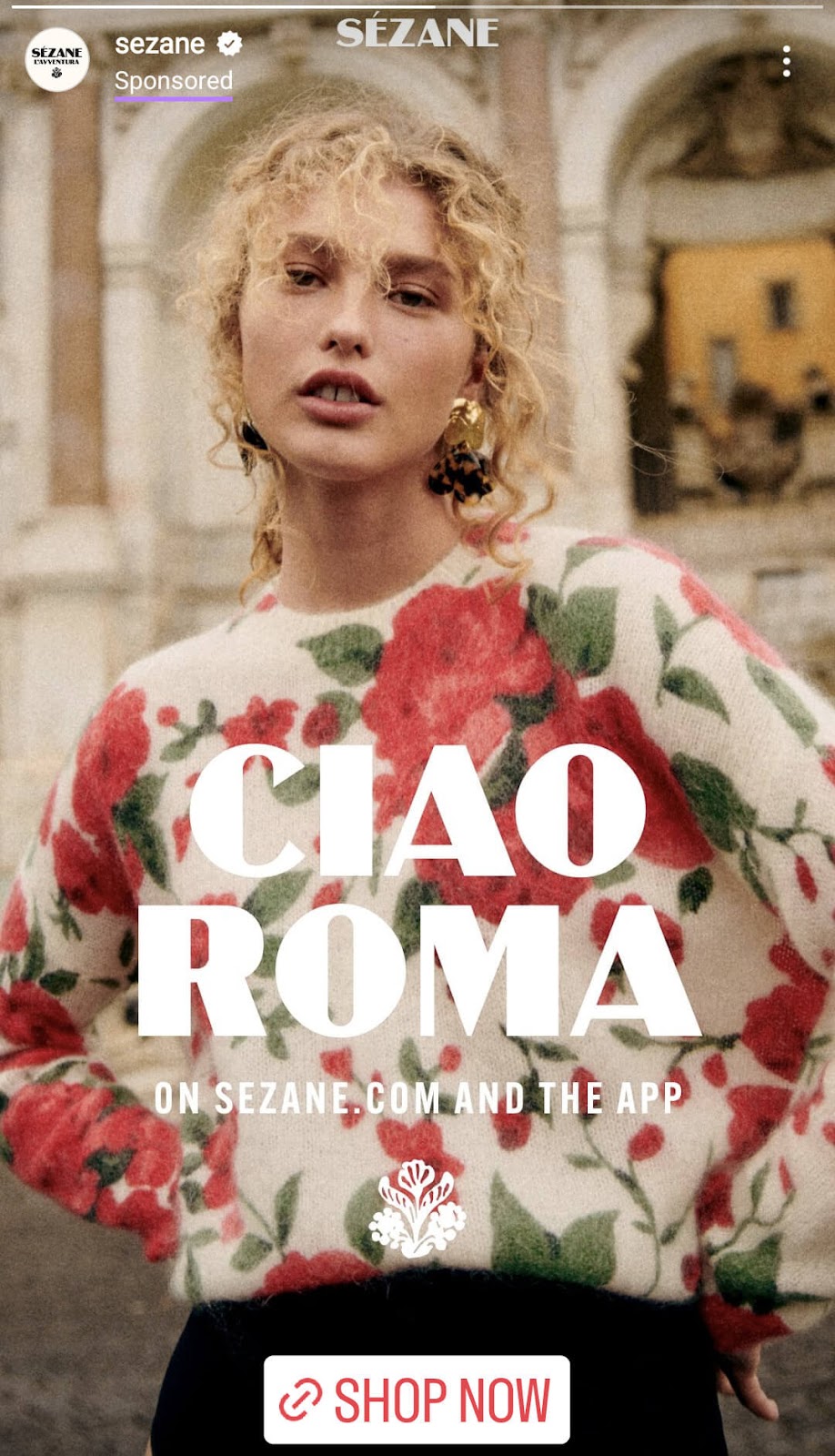
They're full-screen and immersive, giving you a captive audience for your message.
These ads can include images or short videos. And they always have a clear call to action, like "Swipe Up to Shop."
This format is ideal for time-sensitive offers or promotions. For instance, if you're having a flash sale. The temporary nature creates a sense of urgency.
11. Message Ads
Deliver your advertising directly to users' inboxes on platforms such as Facebook Messenger or LinkedIn with message ads.
Here’s an example from LinkedIn:
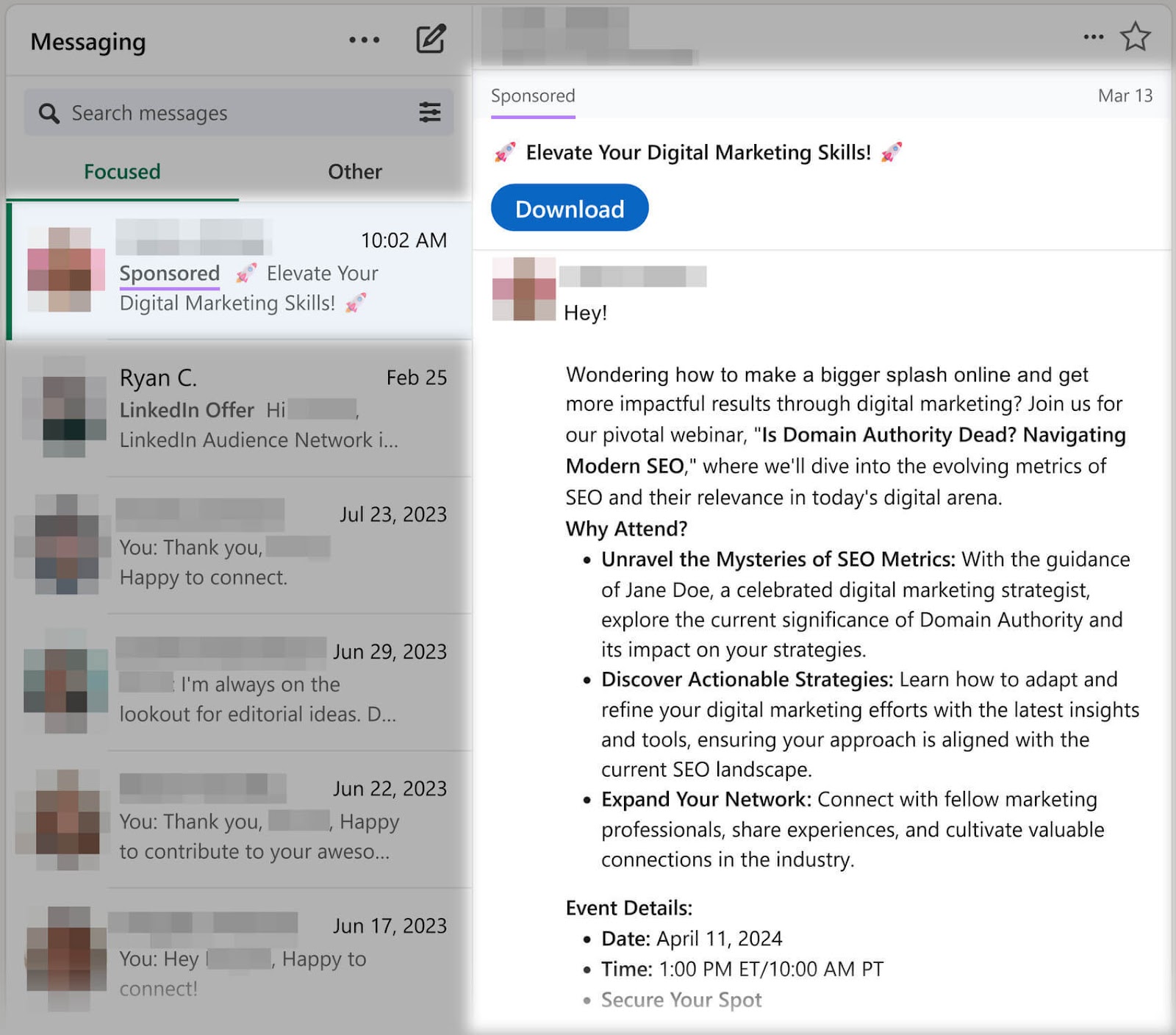
These ads allow for a more personal interaction. They can look just like a regular message, even initiating a conversation by addressing the recipient by name.
Use message ads for targeted promotions, special deals, or exclusive information. For example, send a message ad about an upcoming webinar to users who have shown interest in your industry and invite them to attend.
Content and Native Advertising
Native ads, often articles or videos, mimic the look and feel of the media format where they appear.
The goal is to provide value through content that feels authentic to the platform. The ads are designed to be part of the editorial flow.
Common types of content and native ads include:
12. Sponsored Content
Share your brand's story or products on third-party websites with sponsored content. It looks just like that site's own articles or videos.
Here's an example of a sponsored post on Forbes:

When you make sponsor content, you work with the third-party websites to create stories or videos that fit right in with what they usually post. But your sponsored piece contains messaging that’s good for your brand.
This type of content is great to draw in readers who are already interested in topics related to your brand. It's a smart way to introduce them to what you offer.
13. Branded Content
Tell your brand's story through branded content, engaging your audience with narratives that reflect their lifestyles and values without a direct sales pitch.
This type of content (often in the form of videos, articles, or social media posts) reinforces your brand's voice and personality.
Here's an example of branded content created by Casey Neistat featuring Nike:

While branded content often features products, the primary goal is to engage viewers emotionally and strengthen brand loyalty by aligning with their passions, interests, and values.
14. Influencer Marketing
Team up with social media influencers whose followers are part of your target market. Boost your brand or promote your product for direct sales by leveraging their appeal and their followers’ trust.
Influencer marketing involves partnering with (and compensating) influencers to create content that naturally includes your products or services.
Here’s an example of a paid post by an influencer on Instagram:
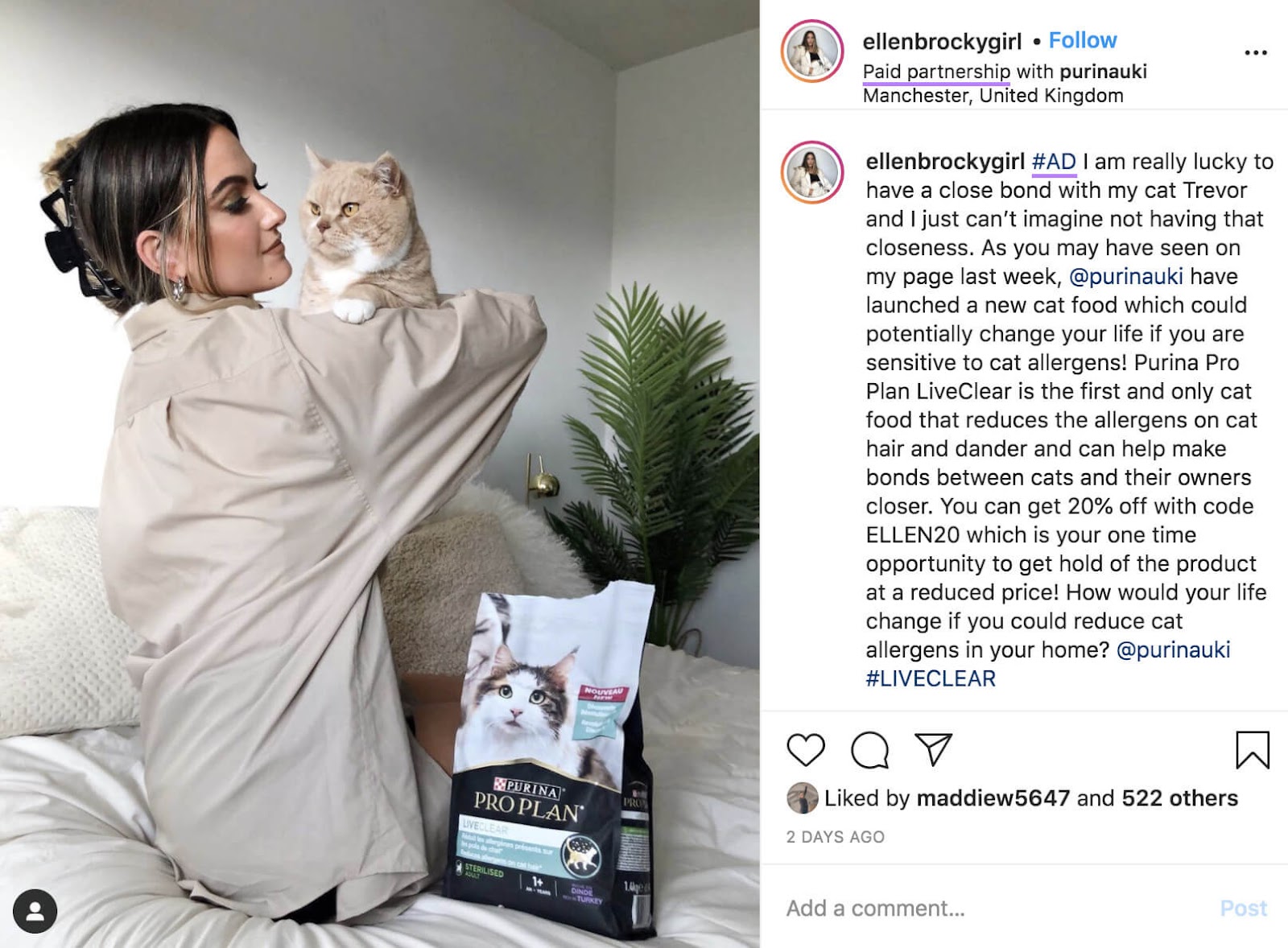
The influencer's endorsement serves as a recommendation to their audience, making it a potent way to influence purchase decisions among their followers.
This is especially effective when targeting younger demographics who value authenticity and personal recommendations.
15. Newsletter Ads
Use newsletter ads to reach people with specific interests or within specific niches. These ads can range from simple text links to full-banner images. Either way, they are integrated to complement the newsletter's content.
Here’s an example of a newsletter ad from Ryan Holiday’s Daily Stoic newsletter:
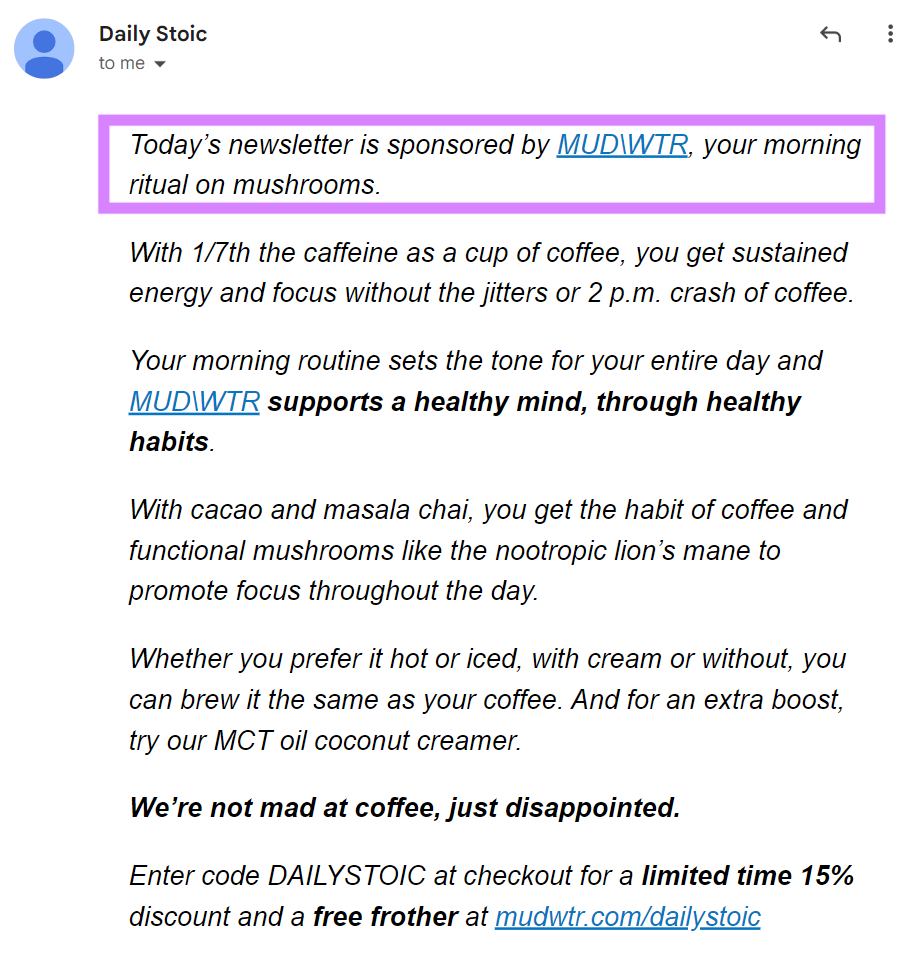
Newsletter ads are particularly effective for B2B companies or niche products, where targeted communication can directly influence decision-making.
16. Content Syndication
Republish your original content on other websites to reach their audience with content syndication.
Here’s an example:
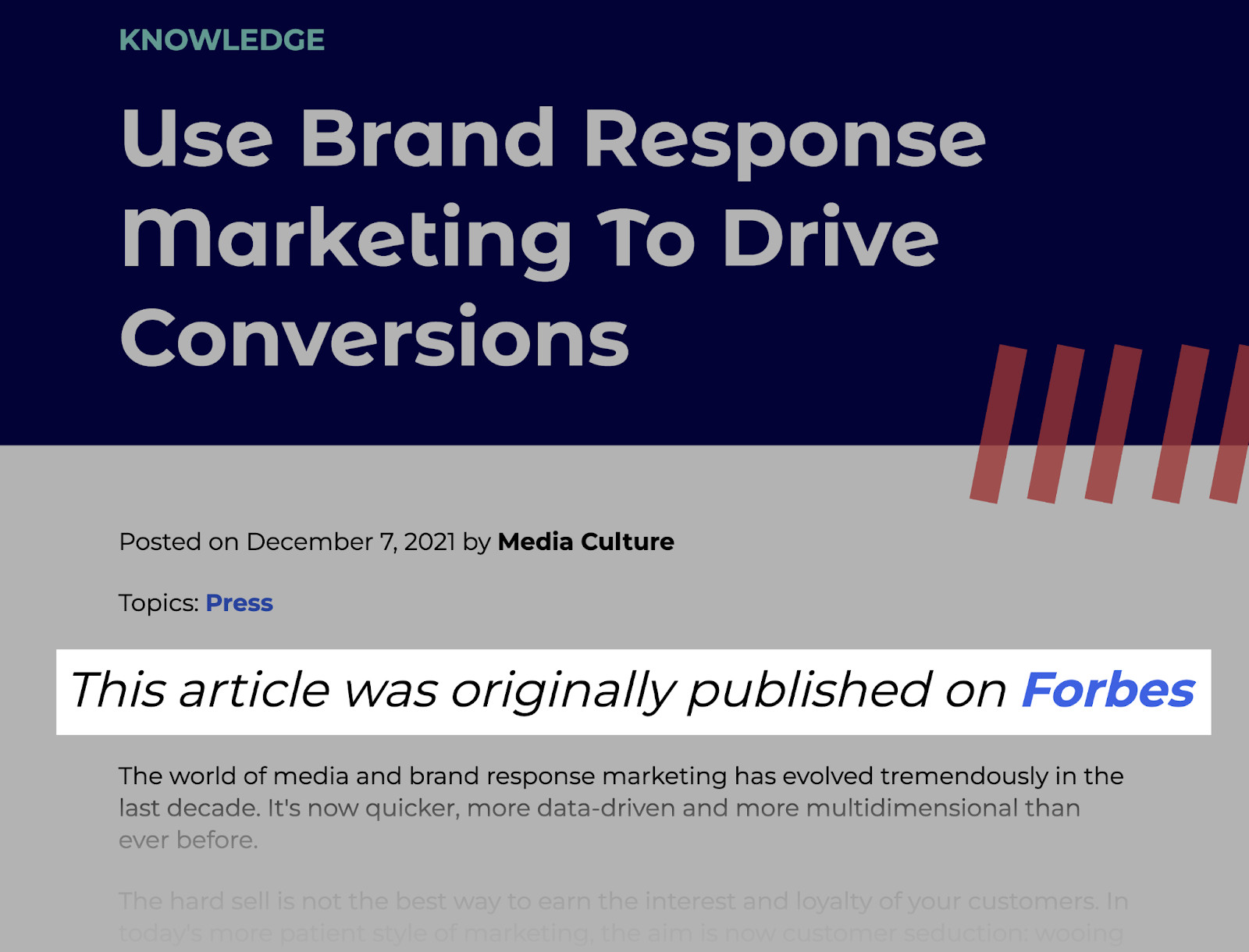
This tactic allows your blog posts, articles, or videos to appear on sites visited by people interested in topics relevant to your brand. And it leverages the credibility and audience of established platforms to enhance your brand's visibility.
Distributing your content to reputable third-party sites helps:
- Increase your brand's exposure
- Drive traffic back to your site
- Reach potential customers outside your immediate audience
Mobile Advertising
Mobile advertising aims to specifically target users on smartphones and tablets.
Here are the common types of digital advertising campaigns used on mobile:
17. In-App Ads
Display your ads right within the mobile apps your target audience is using.
It can be a subtle banner at the bottom of their screen. Or an immersive full-screen ad that appears during their ordinary app interactions.
Here’s an example of an in-app ad:
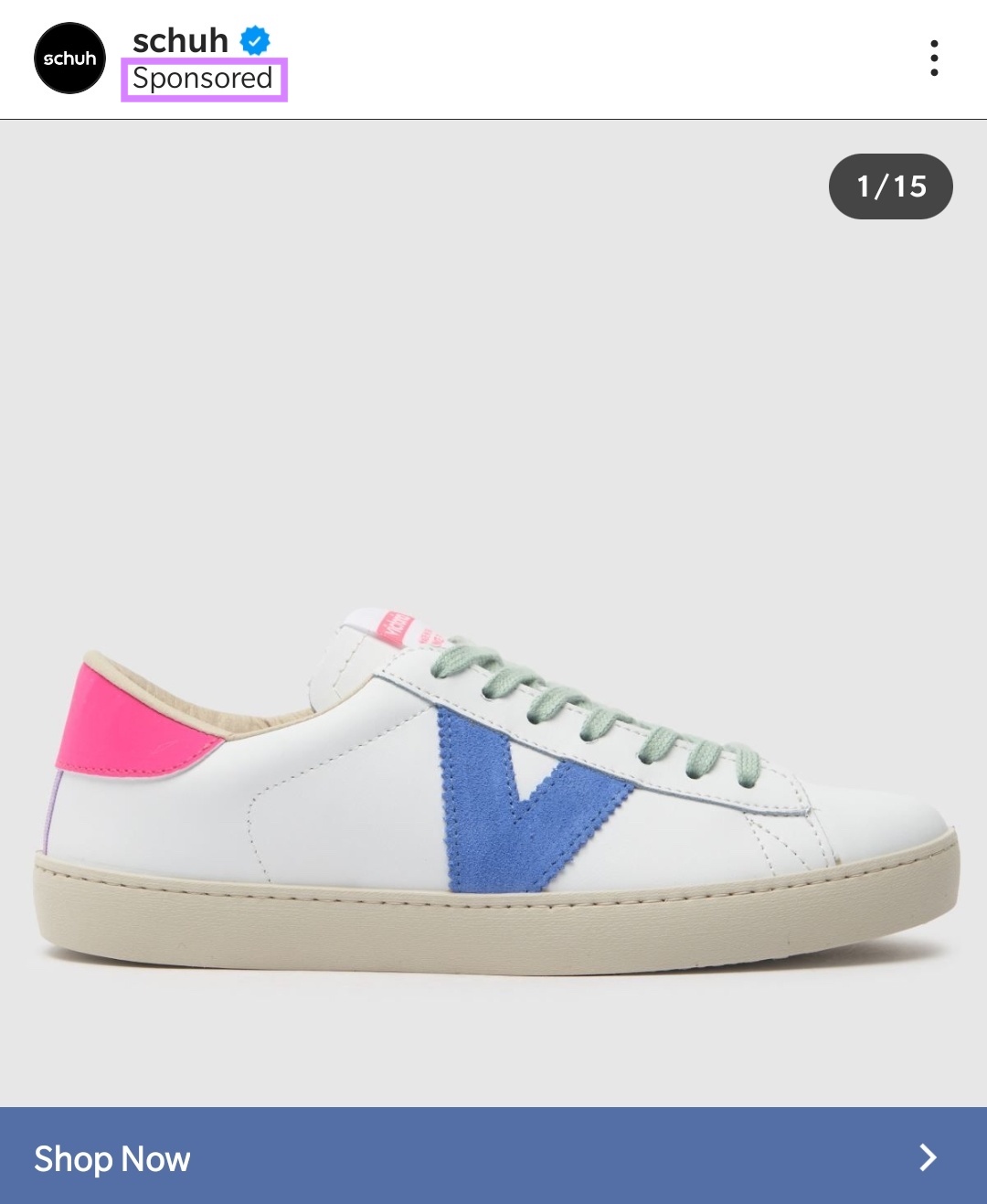
The goal is to advertise your product in a contextually relevant place. Like sports attire advertised in a fitness tracker app.
These ads can be fine-tuned to target users based on detailed criteria, including their app usage patterns, interests, and demographic data. This helps your message reach those most likely to engage with your brand.
18. SMS Marketing
Send concise, direct messages to your audience with SMS ads. These can include sales alerts, appointment reminders, or exclusive offers.
Here’s an example:
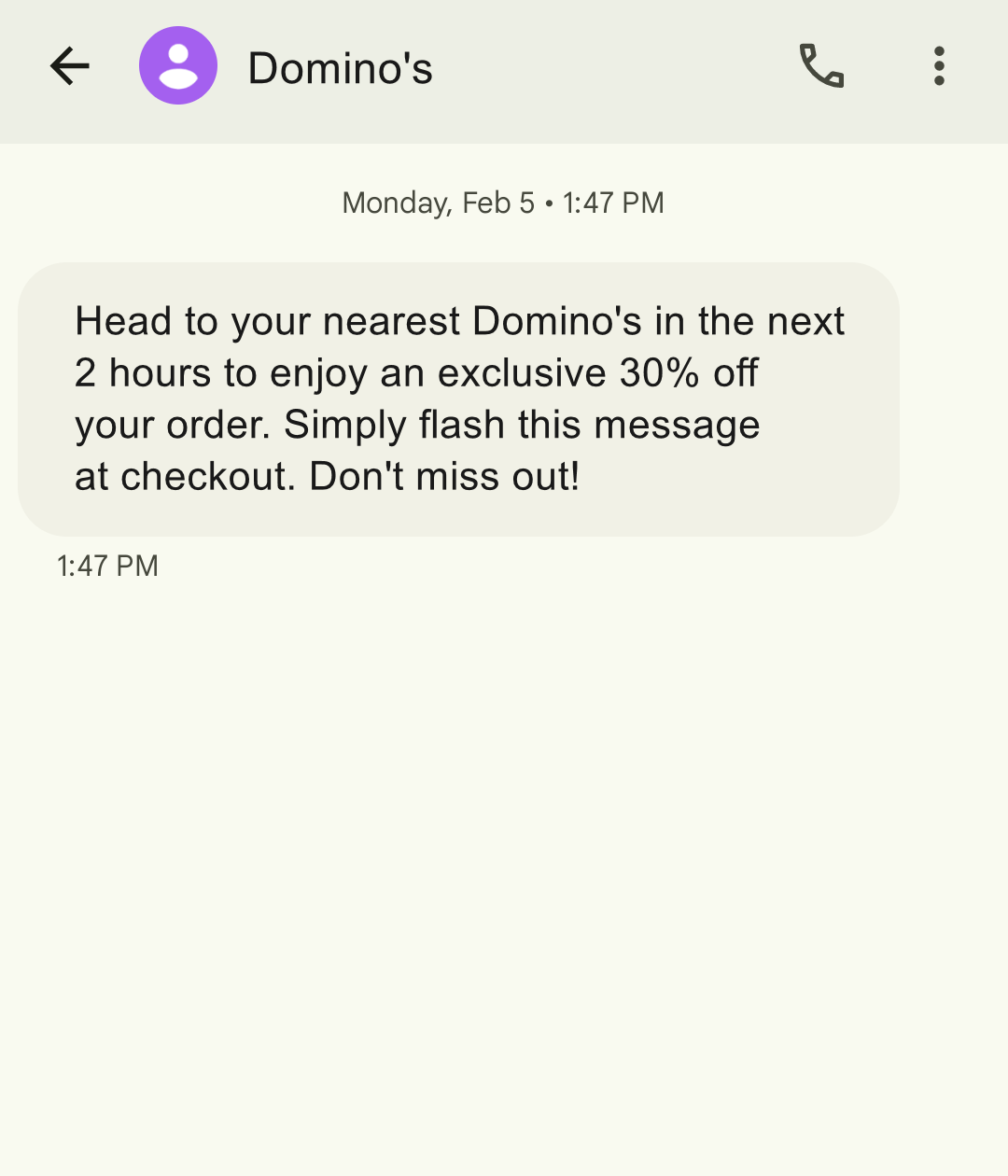
Because text messages are highly personal and have high engagement rates, SMS ads are an incredibly effective way to activate people who have opted in to receive your messages.
They are ideal for time-sensitive promotions or important notifications.
19. Mobile Search Ads
Place ads on mobile search results to instantly reach users on their phones.
These ads are specially designed for mobile. They often feature functionality intended to drive immediate action, like click-to-call buttons or location maps that provide driving directions.
Here’s how it looks:
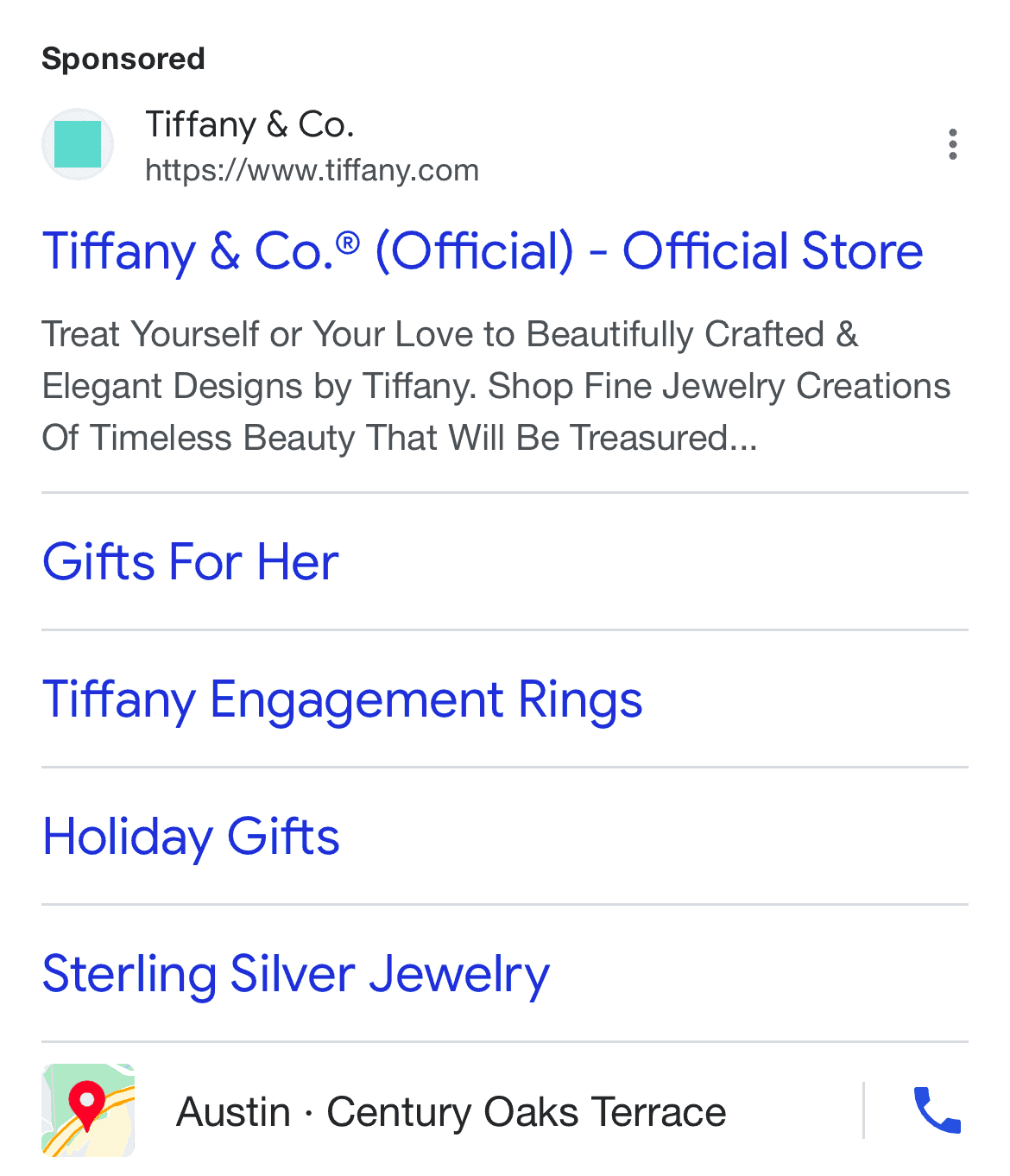
If you're running a local service business, such as plumbing or other repair, mobile search ads can help you connect with users searching urgently for help nearby. You raise awareness about your offerings and make it easy for them to contact you.
Other Types of Digital Advertising
We’ve covered most of the conventional types of digital advertising. But there are still some unique and innovative ad types you should know about.
Here are seven:
20. Banner Ads
Capture attention on websites with banner ads. They appear as graphics at the top, bottom, or sides of the site.
They can be static images or animations that catch the user's eye and encourage clicks.
Here’s an example of a banner ad on The New York Times homepage:
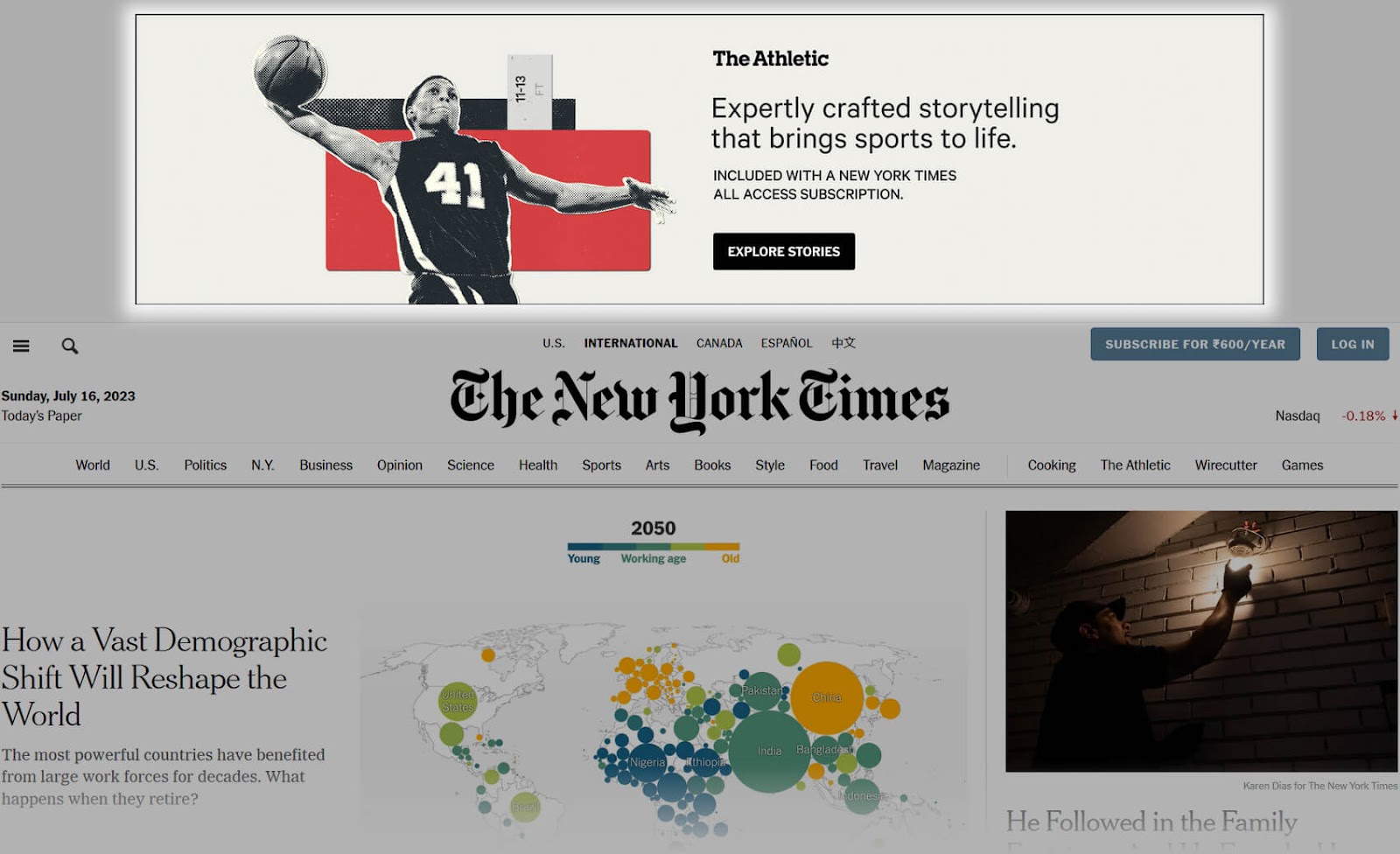
With banner ads, you can target specific websites frequented by your desired audience. And ensure your message is seen in relevant contexts.
For example, if you have a software company, you might use display ads on tech forums to showcase the features of your latest product release. Include a clear CTA, like "Learn More" or "Free Trial."
21. Audio Ads
Engage listeners with audio ads on podcasts, streaming music services, and internet radio. These ads are purely auditory, so your message needs to be clear and memorable.
For instance, if you're promoting a new fitness product, a catchy audio ad on a popular fitness podcast can intrigue listeners and direct them to your landing page.
Platforms like Spotify have robust ad programs.
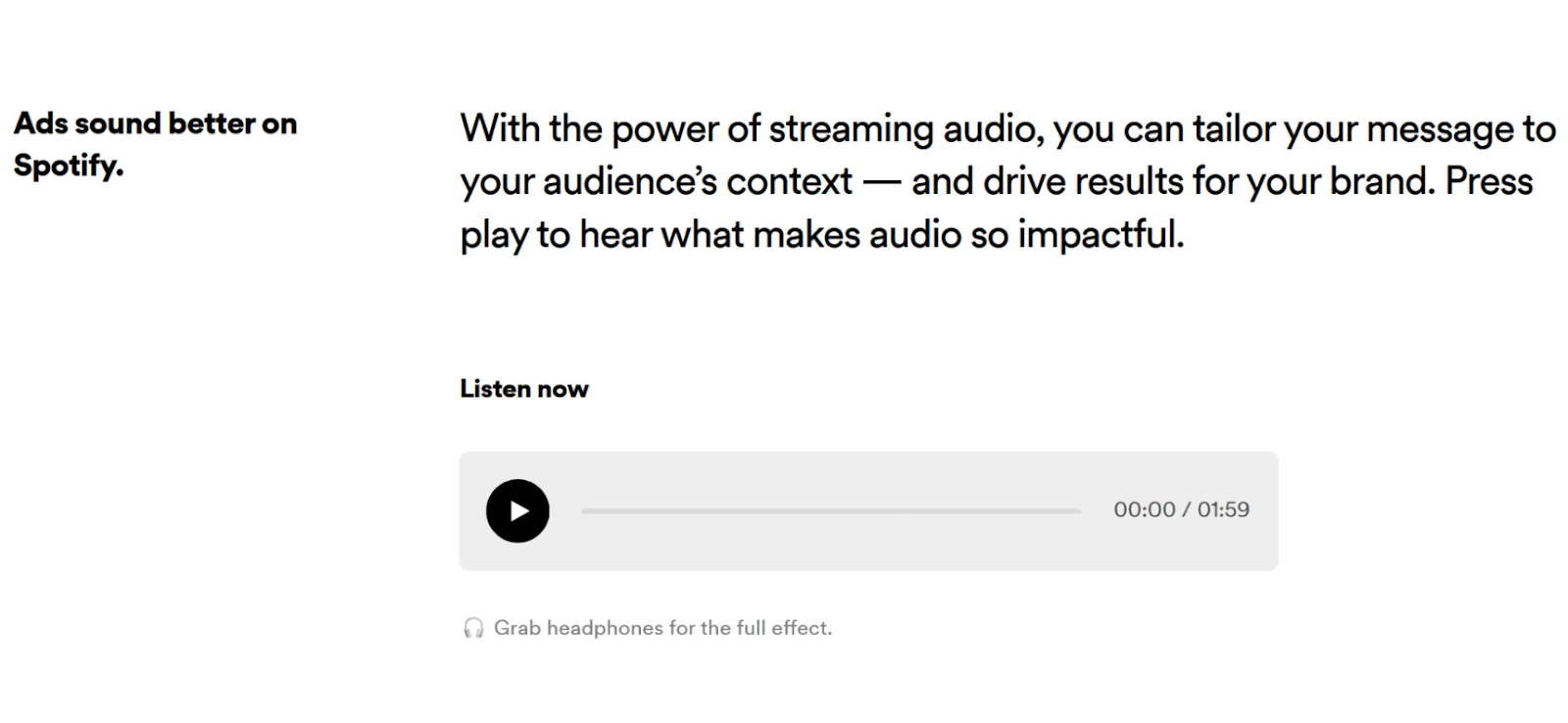
Audio ads are particularly effective for targeting audiences based on listening preferences and habits. And they offer a personal touch by engaging through headphones. They often get a high level of attention.
22. Affiliate Marketing
Collaborate with partners ("affiliates”) to promote your products through affiliate marketing.
These partners could be anyone—bloggers, influencers, or people with dedicated online followings. In return for promoting your product, they earn a commission for each sale or lead they generate.
Let’s say you sell fitness-related products. Partner with fitness bloggers who will review and recommend your products to their followers. Give them a specific URL with a tracking code you can trace back to them. For each purchase their referred followers make, you pay them $20.
Here's an example of a review article on CNET that includes an affiliate link:
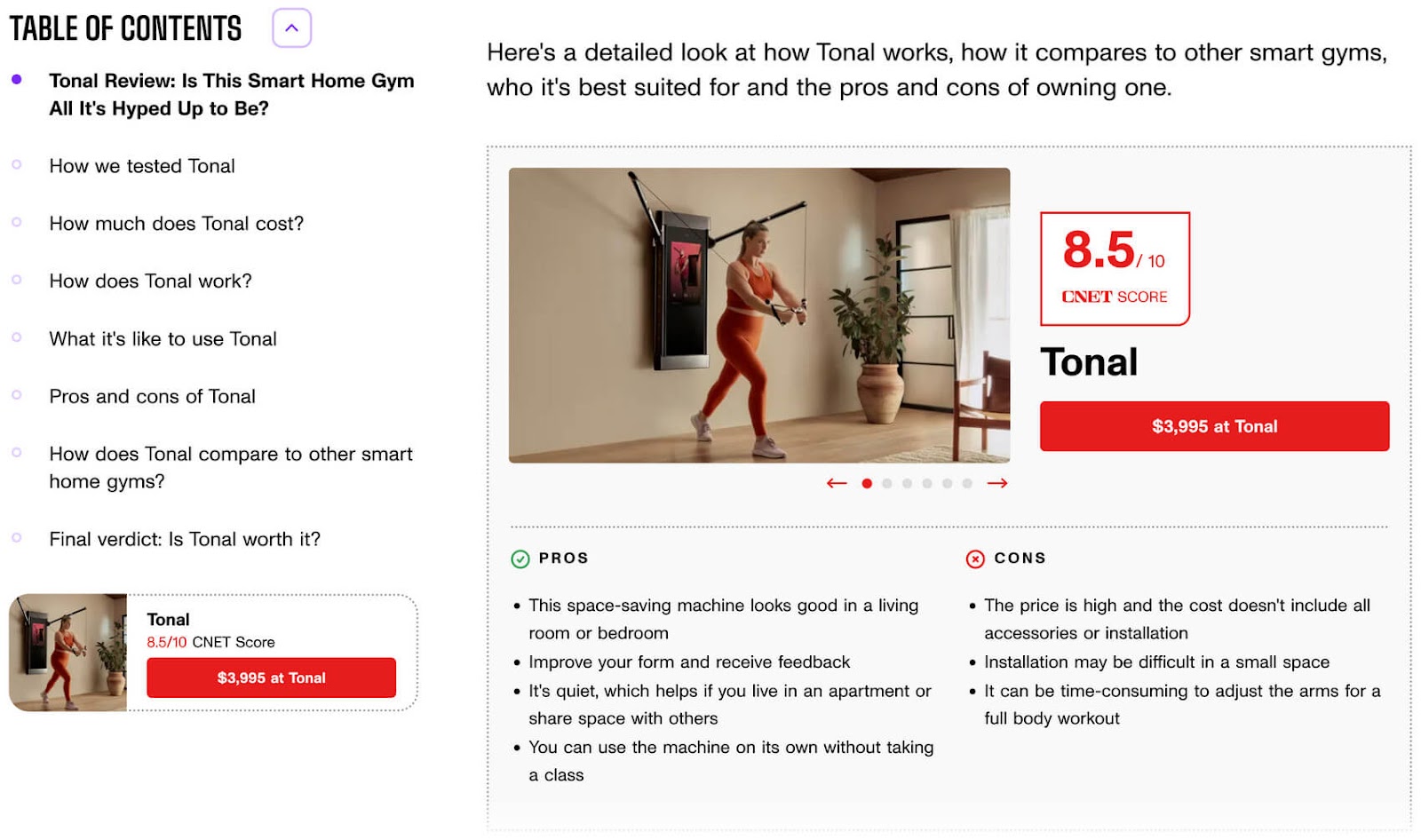
Affiliate marketing is highly effective for expansion. You benefit from the audiences and credibility your partners have built, without needing to create that audience yourself.
23. Gmail Ads
Appear directly in Gmail users' inboxes with Gmail ads. They show up at the top of a user's inbox in the “Promotions” or “Social” tabs.
These ads look like regular emails until they are opened, revealing a full advertising message inside.
Here’s an example:

Gmail allows you to target users based on their email activity.
For instance, if you offer travel deals, target people who have received emails from other travel services, presenting your offers as timely and relevant alternatives.
It’s a unique way to present your message directly where your audience manages their daily communications.
24. Amazon Ads
If your products are listed for sale on Amazon, you can showcase them to shoppers with Amazon Ads.
These ads appear in search results and on product pages, providing visibility right at the point of purchase. They highlight your products with images, pricing, and customer ratings.
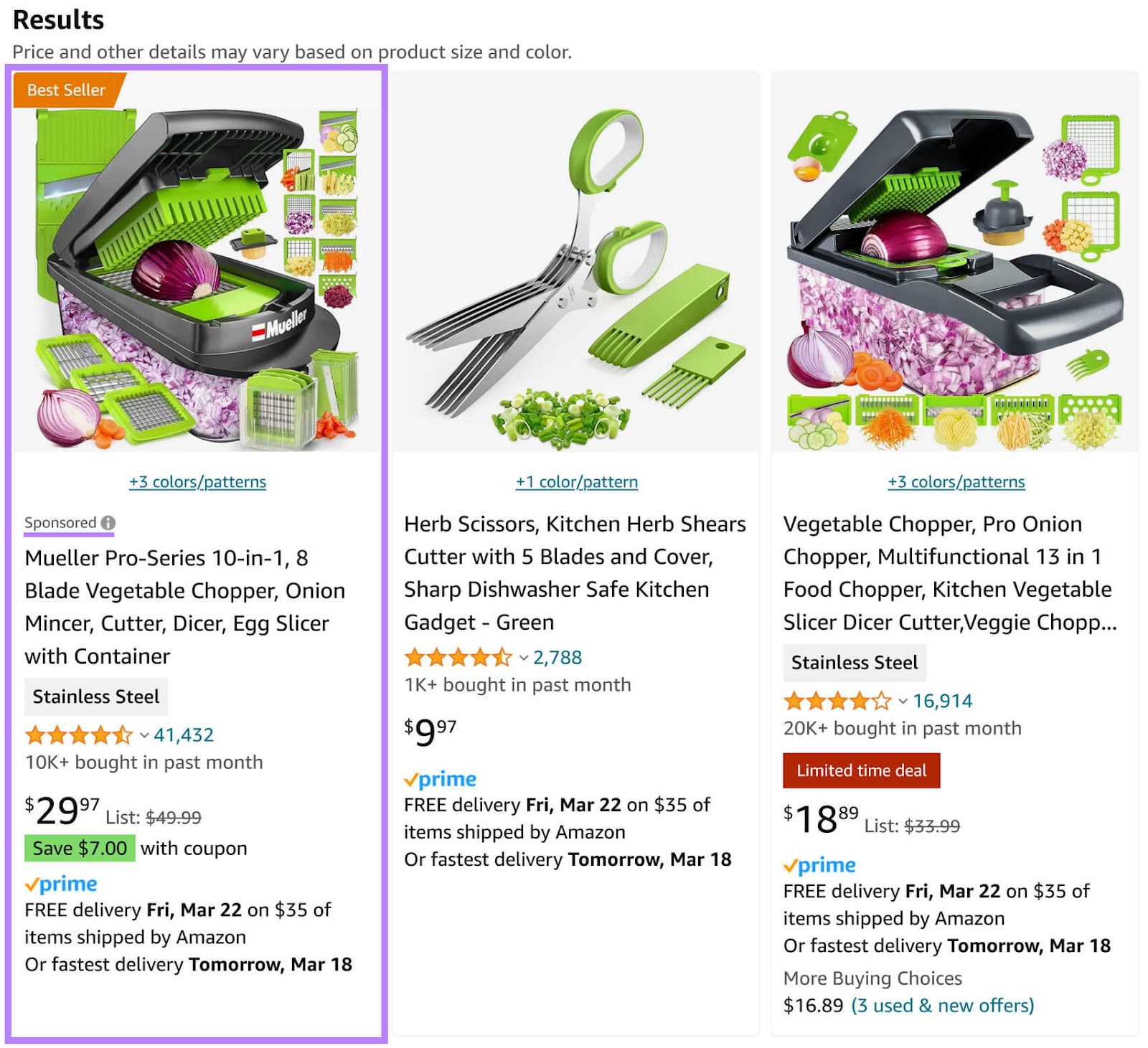
Amazon's vast data on shopping behavior allows for precise targeting. Which helps you reach consumers who are already interested in products like yours.
25. Retargeting Ads
Reconnect with users who previously visited your website with retargeting ads.
By using cookies, these ads find past visitors wherever they may be across the web. Reminding them of the products they viewed or encouraging them to complete a purchase back on your site.
Here’s an example:
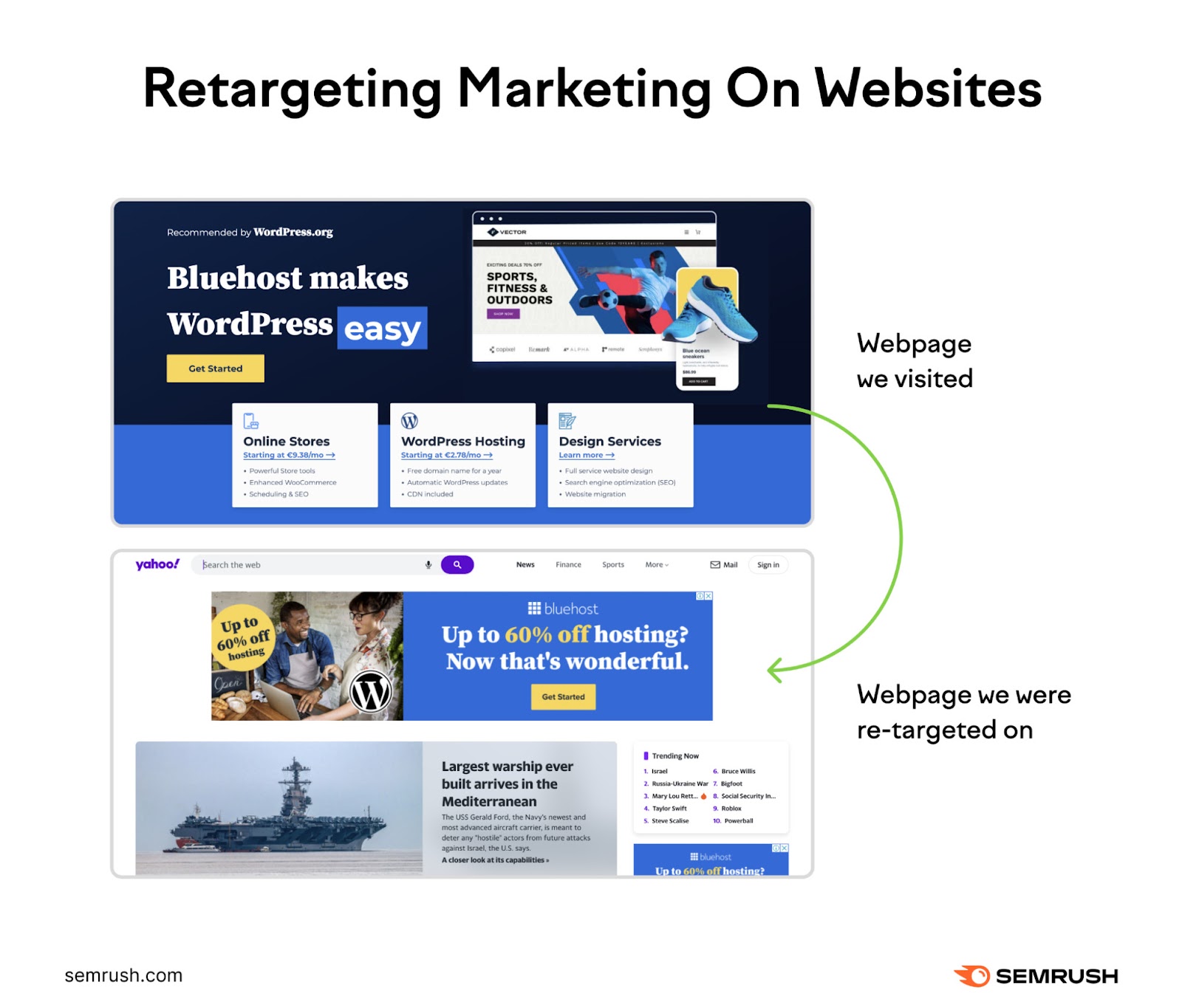
Retargeting is highly effective. It keeps your brand and the specific products of interest top of mind for potential customers.
26. AR/VR Ads
Create immersive advertising experiences with augmented reality (AR) and virtual reality (VR).
These ads engage users by:
- Blending digital elements with the real world (AR)
- Creating a fully virtual environment (VR)
An AR ad might let users see how furniture would look in their home using their smartphone camera. A VR ad could transport users to a virtual world where they can interact with your product.
These ads are especially effective for products that benefit from experiential marketing. They offer a unique and memorable way to showcase features and benefits.
Here’s an example of Burger King leveraging AR in its ad:

How to Pick the Best Digital Advertising Type
To ensure your marketing efforts are as effective as possible, select digital advertising types that align with your goals and audience.
Here are a few factors to keep in mind:
- Your target audience: Understanding your customers’ habits, preferences, and online behavior is key. For instance, younger audiences might be more engaged with social media ads, while professionals may respond better to LinkedIn.
- Campaign goals: Establish what you want to achieve with your campaign. If brand awareness is your goal, display or video ads might be most effective. For direct sales, search ads or affiliate marketing could be more suitable.
- Budget constraints: Some ad types are more cost-effective than others. Programmatic ads can be optimized for efficiency, while influencer marketing might require a significant investment but offers high engagement rates.
- Content type: The nature of your product or service can also dictate the ad type. Complex products might benefit from detailed explanation in video ads, whereas simple product offers can excel in static image ads.
- Platform compatibility: Certain products might perform better on specific platforms. For example, visually appealing products like fashion or home decor thrive on visual-centric platforms like Instagram or Pinterest.
Using more than one type of digital ad can help you reach more people and drive better returns for your campaign.
For example, you could use search ads to attract people looking to buy something immediately. And at the same time, use social media ads to get more people familiar with your brand.
Use different types of digital ads to connect with customers at different times. This will make your overall advertising strategy more complete.
Ready to Run Your Ad Campaign?
These two steps will inform a more effective strategy:
1) Understanding your market
2) Analyzing your competitors
Semrush offers 55+ tools for market research and competitive analysis. They’ll help you plan, implement, and analyze your ad campaigns. Best of all, you can try them for free.
Get started with Market Explorer. Analyze your market size, competition level, target audience, and traffic trends.
Open the tool, choose "Find Competitors," and enter your competitor's domain. Select a location if you want to. Then, click "Research a market."
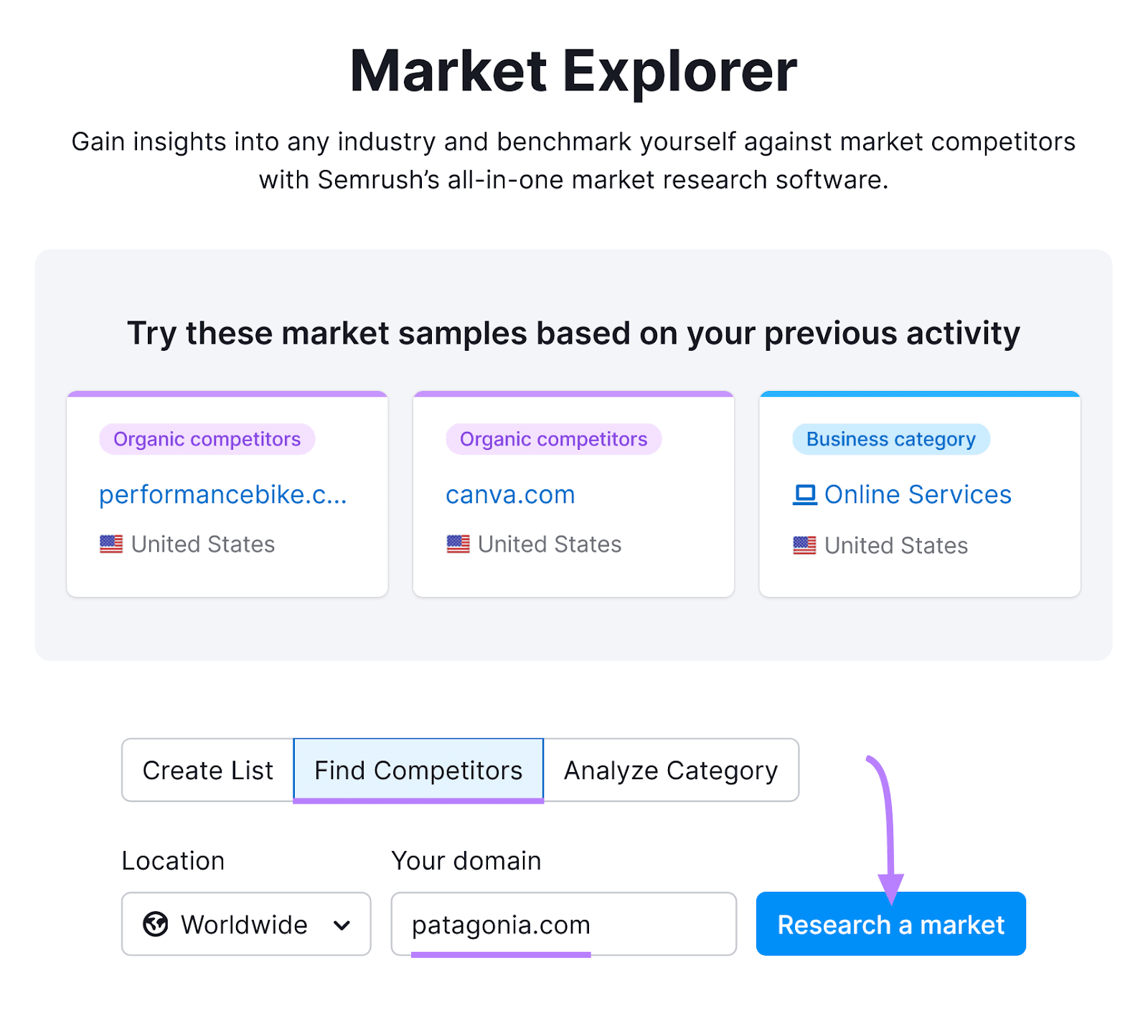
You'll see an “Overview” report that gives a snapshot of your target audience, competitors, and industry.
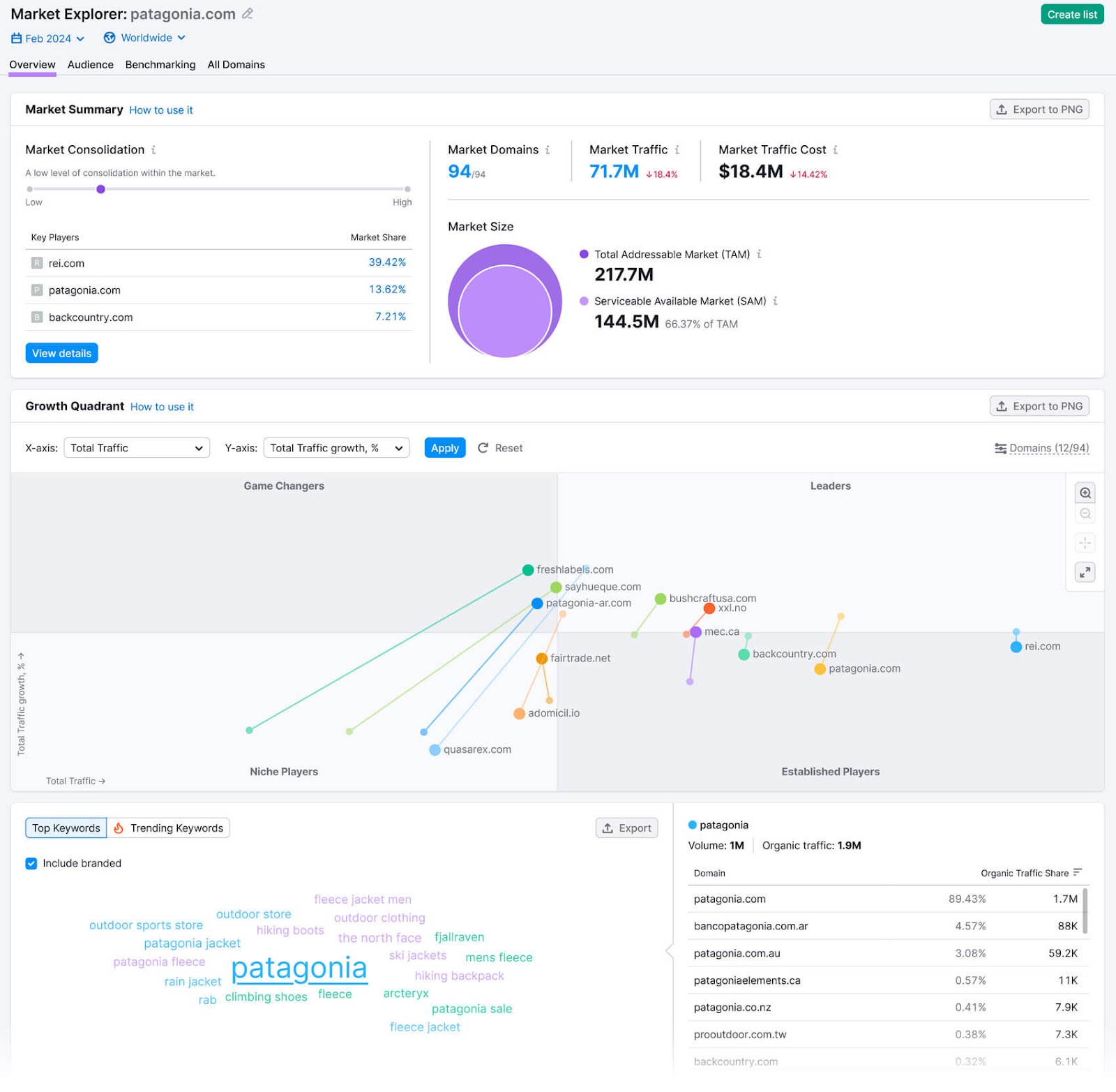
Review these insights, get to know your audience and your competitors better, and then create an ad strategy accordingly.
Sign up today for a 14-day free trial.
